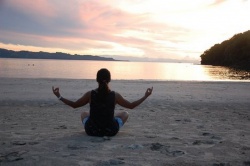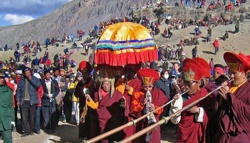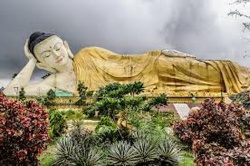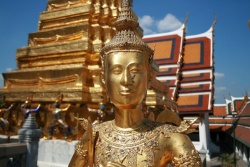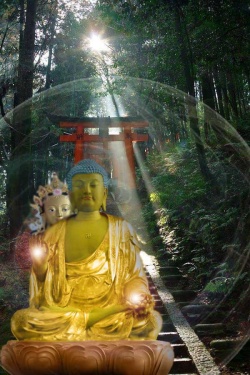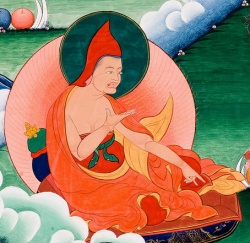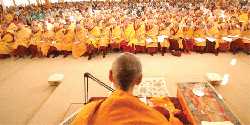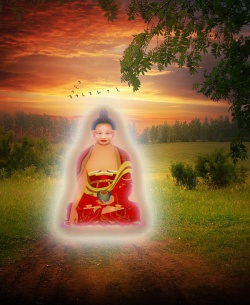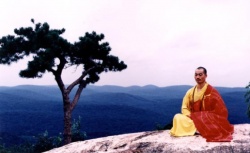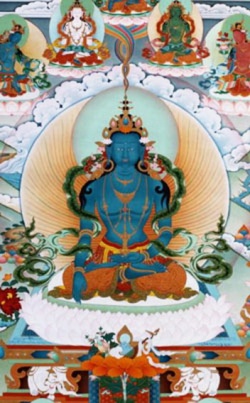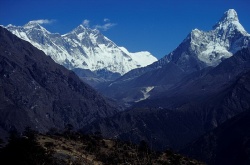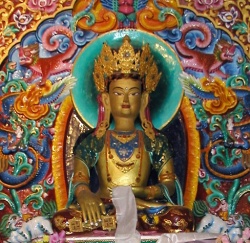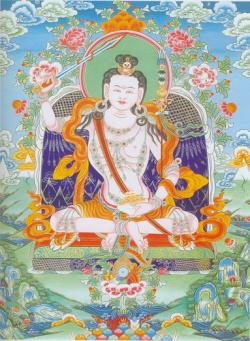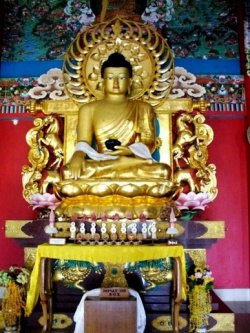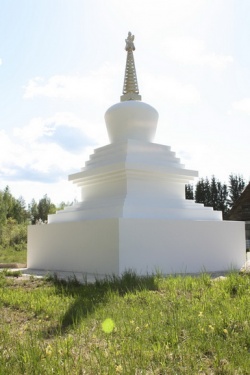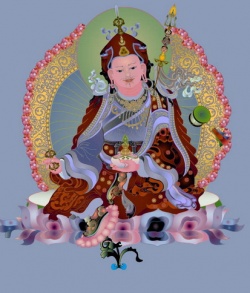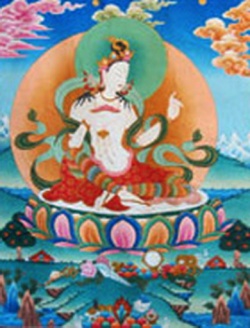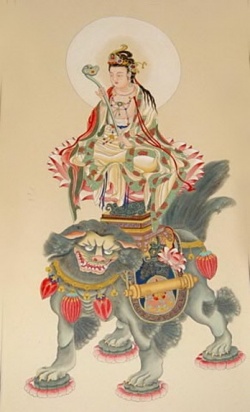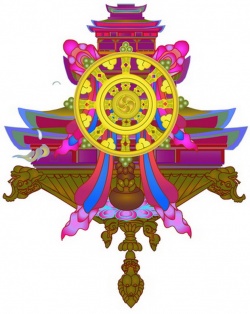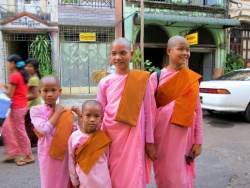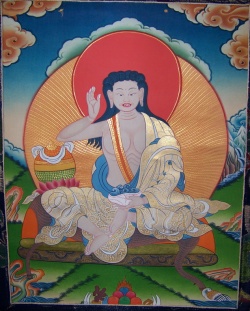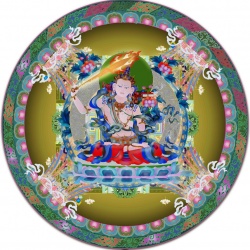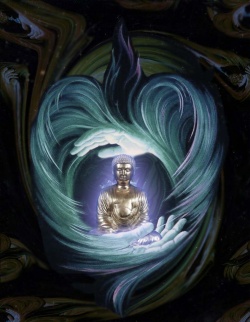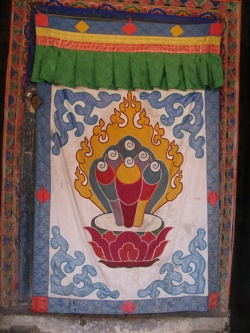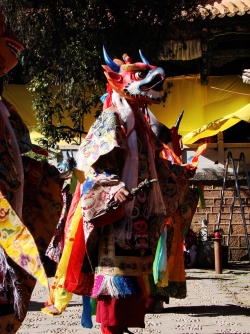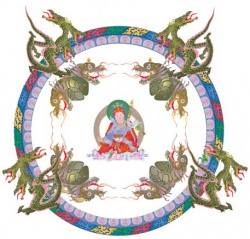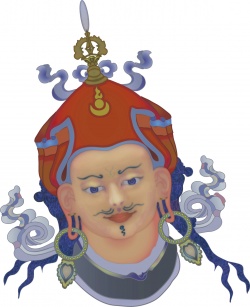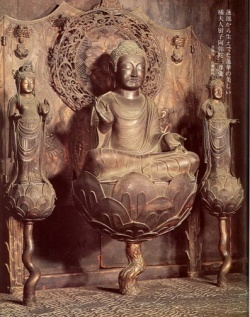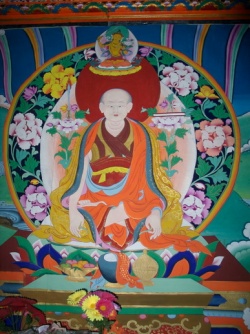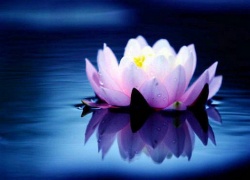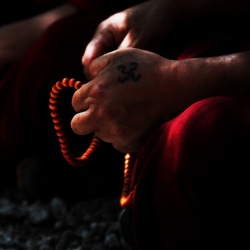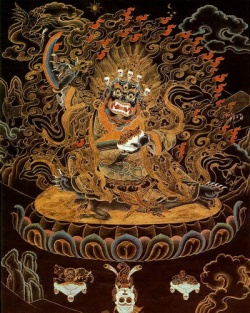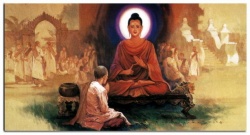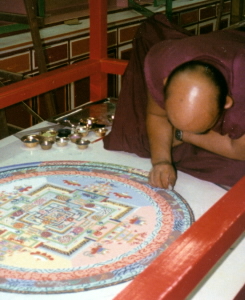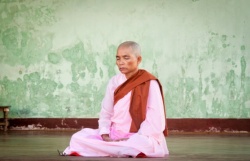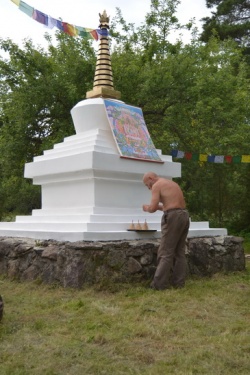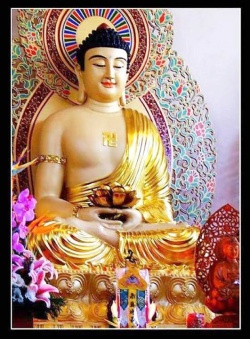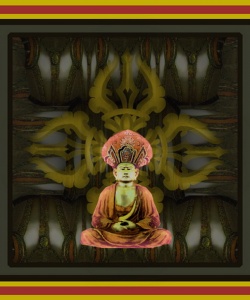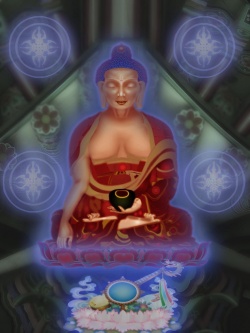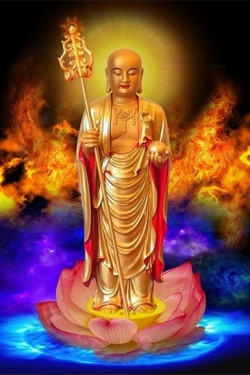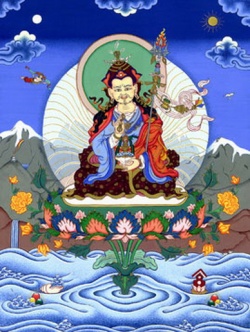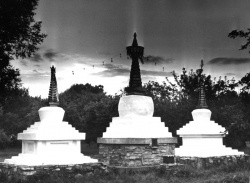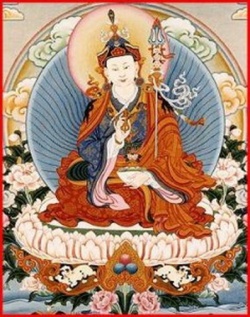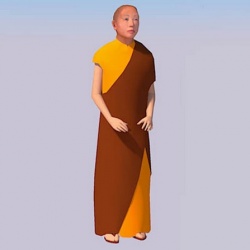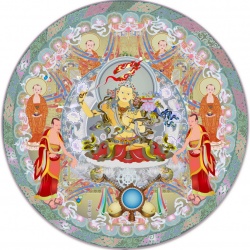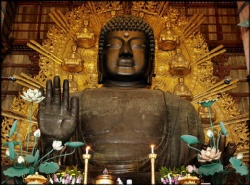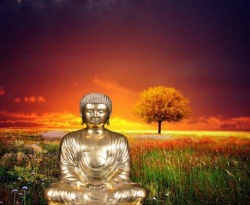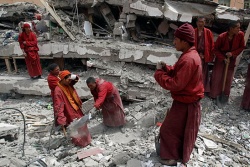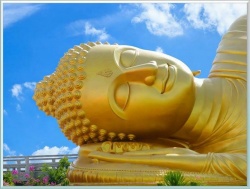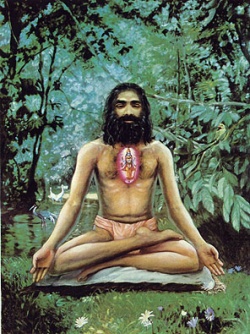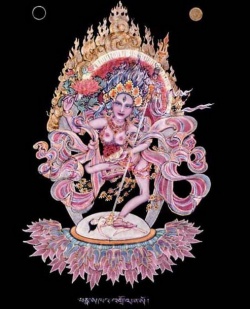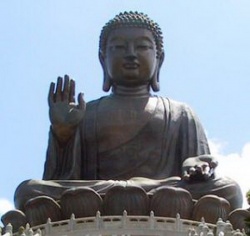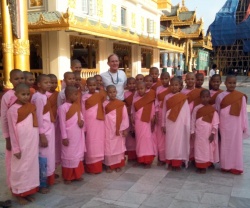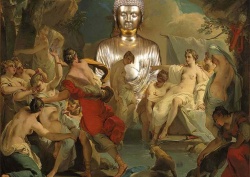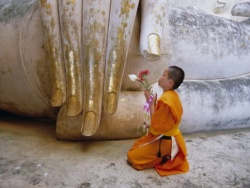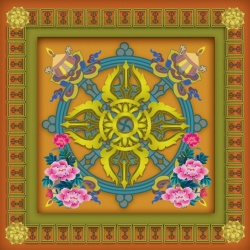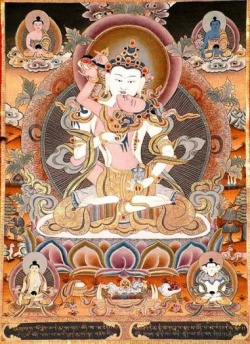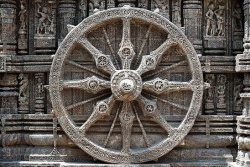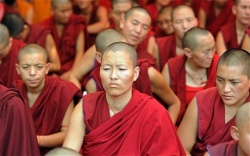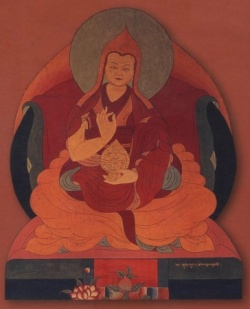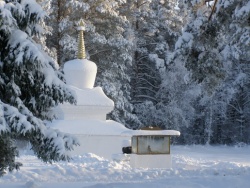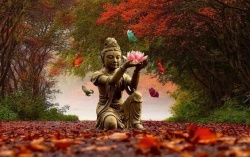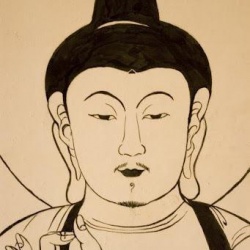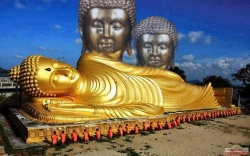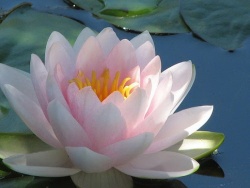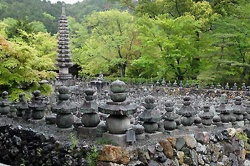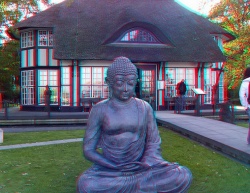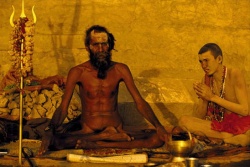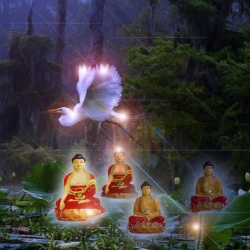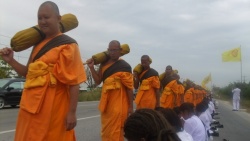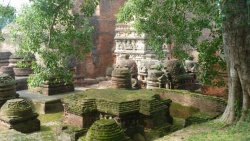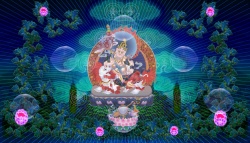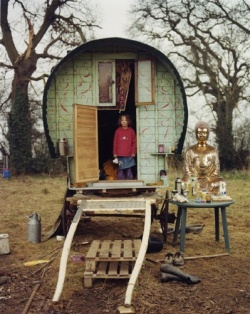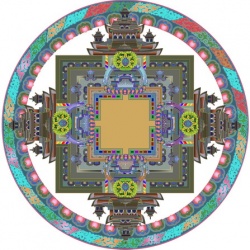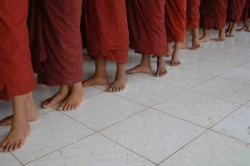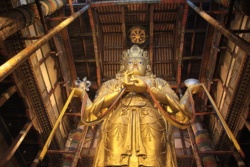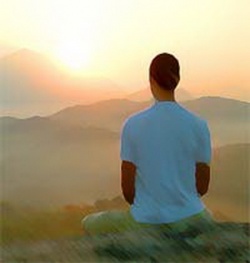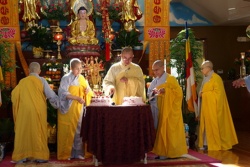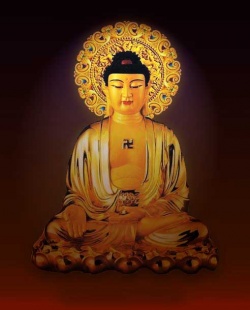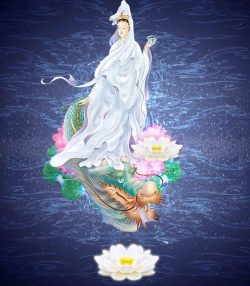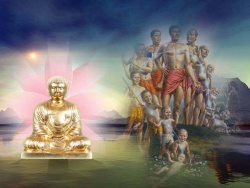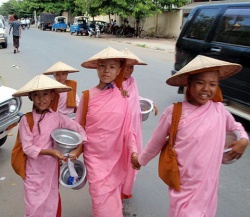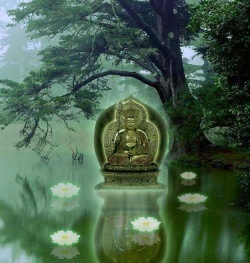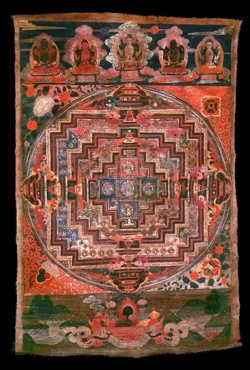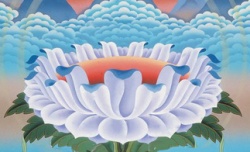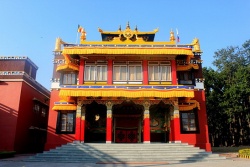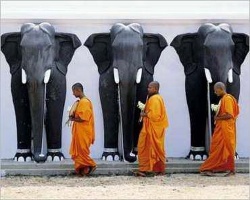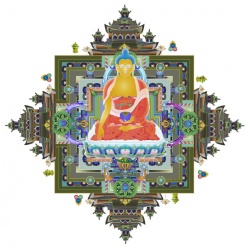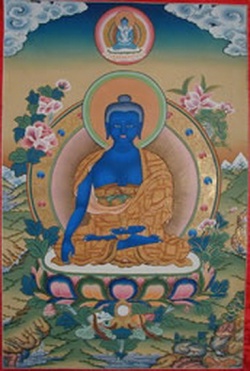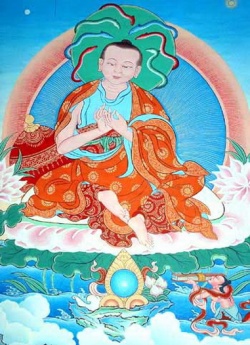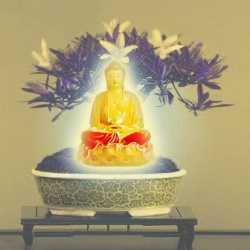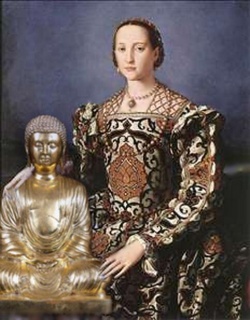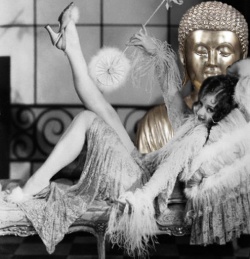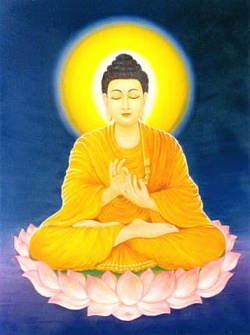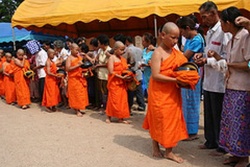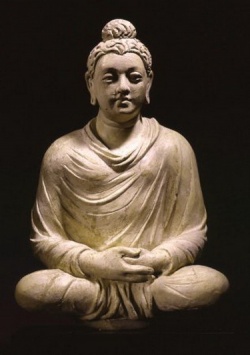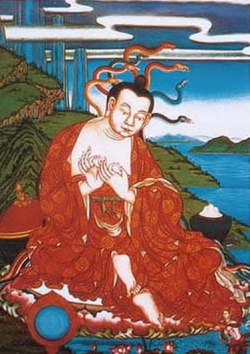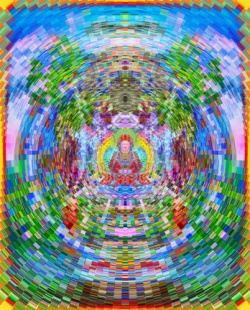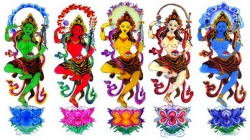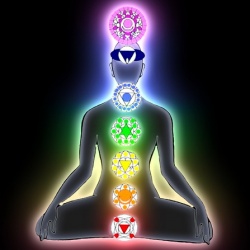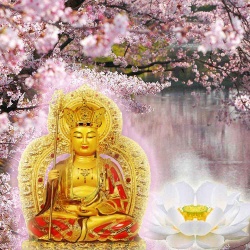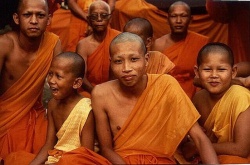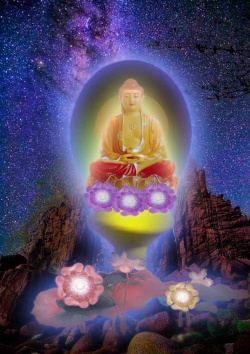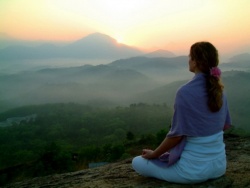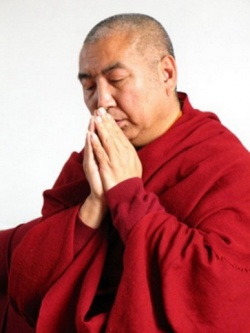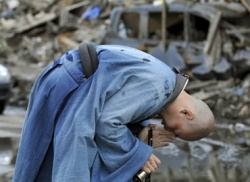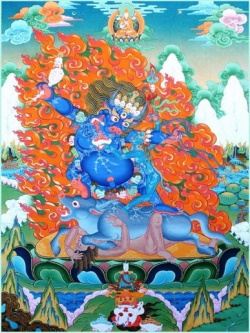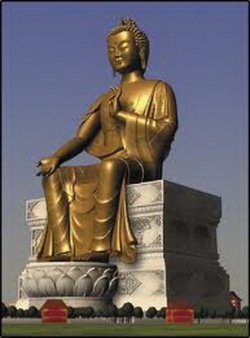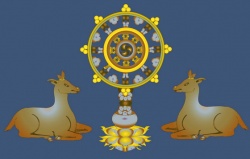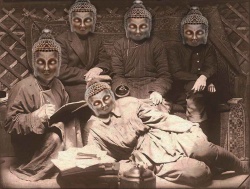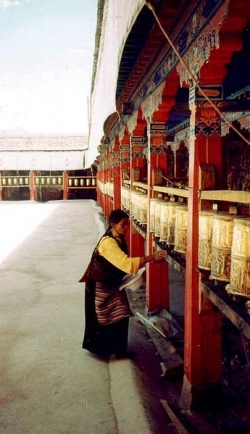A Spiritual Teacher
"Rely on the teachings to evaluate a guru:
Do not have blind faith, but also no blind criticism."
His Holiness the Dalai Lama
==WHAT IS A SPIRITUAL TEACHER?==
The role of a spiritual teacher or guru is often misunderstood in the West. For one thing, we lost the ancient system of studying under one teacher for many years to learn a craft like carpentry or masonry, and we are not used to this system anymore. There is a lot of confusion about spiritual teachers; some people may believe that a guru will take over the entire responsibility of a disciple's life, leaving the pupil more like an obedient, mindless puppy.
"It seems that most students actually want to remain little children and idolize their holy daddy, and holy mommy."
Scott Mandelker
But nobody can take over our own responsibility for the way we live our life (see the page on karma). Even if we leave some decisions over to someone else, we are still responsible for our actions - including shifting the decisions to someone else.
As Sogyal Rinpoche warns in The Tibetan Book of Living and Dying:
"The West has become a heaven for spiritual charlatans. ... without the guidelines and criteria of a thriving and full-fledged wisdom culture, the authenticity of so-called "Masters" is almost impossible to establish."
We need to be realistic about spiritual teachers: if we want to learn something, a teacher is needed, or is at least very useful. How far would we have come with learning to read and write without a teacher?
"If you are only studying Dharma for the sake of study, sake of development of your understanding of Dharma, if you are only studying Dharma intellectually, just intellectually on intellectual level, then I don't think you need a guru-disciple relationship. And also you can study with all kinds of teachers. It's like going to university. You study with different
teachers or professors, and you go on, you move on. But if you wish to commit yourself to the path, then it is necessary, because one needs to know how to accomplish the realization, how to practice the Dharma."
Zasep Tulku Rinpoche
In Buddhism it is essential to realise that the teacher is ultimately important because he/she can lead us to our own inner wisdom - our own 'inner guru'. We need to develop our own wisdom and insight to become a teacher and in the end, even a Buddha ourselves. In that sense, a guru is like our spiritual mother; in the beginning of the path, we are pretty helpless and need much help and guidance; but in the end, we should be able to stand on our own feet and be self-sufficient.
"A guru is a person who can really show you the true nature of your mind and who knows the perfect remedies for your psychological problems. Someone who doesn't know his own mind can never know others' minds and therefore cannot be a guru."
Lama Thubten Yeshe
A good spiritual friend who will help us to stay on the path, with whom we can discuss our difficulties frankly, sure of a compassionate response, provides an important support system which is often lacking. Although people live and practice together, one-upmanship often comes between them. A really good friend is like a mountain guide. The spiritual path is like climbing a
mountain: we don't really know what we will find at the summit. We have only heard that it is beautiful, everybody is happy there, the view is magnificent and the air unpolluted. If we have a guide who has already climbed the mountain, he can help us avoid
falling into a crevasse, or slipping on loose stones, or getting off the path. The one common antidote for all our hindrances is noble friends and noble conversations, which are health food for the mind."
Ayya Khema
Before you decide to follow a spiritual teacher, it is extremely important to check him or her: there are quite a number of cheats around... In the old Indian tradition, teachers were often checked for 12 years or more before a student fully entrusted a
teacher the spiritual guidance. It is easy to follow people blindly, especially the ones who are smooth talkers and are good salespeople. The reason why gurus are getting such bad names is because people should not have blindly trusted most of them to begin with!
Do take your responsibility serious to check your own feelings; there should be some personal connection; verify if their behaviour concords with their words; are they putting more emphasis on worldly matters than their spiritual path; see what the other disciples say, and of course what other teachers think.
Question: "How does one choose a teacher of spiritual subjects or know a teacher to be reliable?"
==His Holiness the Dalai Lama:==
"This should be done in accordance with your interest and disposition, but you should analyze well. You must investigate before accepting a lama or teacher to see whether that person is really qualified or not. It is said in a scripture that just as fish that are hidden under the water can be seen through the movement of the ripples from above, so also a
teacher's inner qualities can, over time, be seen a little through that person's behavior. We need to look into the person's scholarship -- the ability to explain topics -- and whether the person implements those teachings in his or her conduct and experience."
Jamgon Kongtrul Lodro Thaye from The Teacher-Student Relationship:
"...it is difficult to recognize an authentic teacher, because these qualities are internal. We can not depend upon external factors, but external factors are what we see. It is very difficult to see the inner qualities of another person. A
businessman might be friendlier to us than our best friend, while his unseen motivation is merely to make a sale. Likewise, if a "teacher" acts in a very kind and loving manner towards us it does not necessarily mean that he is compassionate and
selfless, because we cannot see his motivation. We also cannot determine a teacher's qualifications based upon her fame, or whether she has thousands of students. So the seeker is left with this paradox.
There is no simple solution, but there are things we can do. First, it is important that we familiarize ourselves with the characteristics [of a spiritual teacher) discussed by Kongtrul Rinpoche. Second, we must maintain awareness of our own
motivation during the process of finding a teacher. Am I seeking a teacher in order to attain enlightenment for the benefit of all sentient beings, or am I seeking to fulfill my need to acquire the prestige associated with a famous teacher, or am I merely attracted to a lama's beautiful retreat land or the social scene of a hip sangha, and so on.
These motivations need to be acknowledged if we are to recognize an authentic wisdom teacher, because the teacher you find is related to your karma, and your karma is intimately connected to your motivation. Fortunately, there are methods that help us purify our motivation and create the proper conditions for finding a
wisdom teacher, such as bringing our awareness to our motivations as much as possible, doing daily meditation practice, and praying to the Triple Gem (Buddha, Dharma, and Sangha) that we will meet and recognize an authentic wisdom teacher."
In tantric Buddhism, a guru is absolutely essential for the initiation, practice and guidance along the path. Having a tantric teacher and practising "guru devotion" was actually a secret practice for a long time, as the teacher-disciple
relationship is very close in order to achieve the best results. So close in fact, that it can easily lead to misunderstanding in the outside world. More information on a tantric guru can be found on the tantra page.
REASONS FOR FOLLOWING A GURU
We need help on the spiritual path to guide us finding the right way. Obviously the best person to accompany us as a tour-guide is someone who has already successfully travelled the path. This person can help to quicken our progress and avoid obstacles.
Why do we need an experienced guide? I like the following story with a cynical undertone from Rama Krishna:
"Tapobana the Master, had a disciple who served him with diligence. The master kept him solely because of this diligence
and the services he rendered, for he found the disciple rather stupid. One day, the rumour spread throughout the whole region that Tapobana's disciple had walked on water. He had crossed the river as if he crossed a street. Tapobana called his disciple and questioned him. 'Is it true what people say? Did you actually walk over the water?'
'What could be more natural?' answered the disciple, 'It is thanks to you, blessed one, that I walked over the water. At every step I repeated Your Holy Name, and that is what upheld me.'
Tapobana then thought by himself: 'If my disciple can walk over water using my name, what would be impossible for me, his
master? If in my name miracles take place, I must possess powers I did not suspect, and I must be more holy than I was aware of. After all, I never tried to walk on water.'
Without delay he ran to the river bank. With unshakeable faith in himself, Tapobana repeated: 'I, I, I .....' And sank..."
The Buddha compared his teachings to medicine, and the teacher to the doctor who can accurately prescribe the correct medicine for the disciple/patient.
Of course we can have many different teachers, each in some aspect possibly quite important for us. If fact even the school-teacher who taught us to read and write is very important - also in our spiritual life. How else could we read about Buddhism? Every
teacher in our life is important, but there may be one specific spiritual teacher who we may call our 'Root Guru', who inspired us most, and who's advice we really respect and try to follow.
To have a root Guru is especially important if we wish to practice tantra, simply because the methods used are so advanced that we need proper guidance. Not heeding the advice of one's teacher in tantra is important, as wrongly applied techniques can actually lead to serious consequences for ourselves and others, see also the page on Preliminaries to Tantra Practice
==QUALIFICATIONS FOR A SPIRITUAL TEACHER OF BASIC PHILOSOPHY==
Proper ethical behaviour - a guru should not harm others but try to help
Single pointed concentration
No self-grasping or egoistic thoughts
Having love and compassion as main motivations to teach
Realised emptiness, at least have a proper intellectual understanding
Perseverance in teaching
Wealth of scriptural knowledge
More learned and realised than student
Skilled speaker
Given up disappointment in the performance of the students
If possible, try to find a guru who possesses all these qualities, but at least the first 5. This may be difficult enough...
==QUALIFICATIONS FOR A SPIRITUAL DISCIPLE==
Just like a teacher requires certain qualifications, so should a proper disciple fulfill some criteria. A disciple should consider him/herself as a patient, the teacher as a doctor, the Dharma as medicine and should take the medicine by practicing. Like His Holiness the Dalai Lama says: "There is no substitute for hard work"
A proper disciple should avoid the so-called 3 faulty attitudes:
- being like an upside down vessel: refusing to learn and scepticism
- being like a leaking vessel: forgetting everything and showing no interest
- being like a polluted vessel: being very prejudiced and believing to know everything better than the teacher
A proper disciple should fulfil the 3 requisites:
- lack of prejudice, being open-minded
- intelligence and a critical mind: not blindly following orde
- aspiration: wanting to practice and experience results (not just scholarly study
As Lama Govinda writes in 'A Living Buddhism for the West':
"If a chela (disciple) is accepted by a Guru, he has to approach the teacher with trustful openness and devotion; these are the two basic conditions without which spiritual guidance is impossible. It is just here that many Western chelas make it hard for themselves, because they cannot bring themselves to bow to their teacher, and become upset when their
prejudices and opinions are criticised. Even when they profess to love the teacher, they defend their position and defend their standpoint. ... A true guru is not concerned with imposing conformity of thoughts and feelings. He wants to arouse personal
recognition and experience in the chela - not to teach him, but inspire him. But he also wants to liberate his chela from the attachments to opinions, prejudices, and dogmas - nd this is often a painful process."
But, as Lowenthal and Short comment in 'Opening the Heart of Compassion':
"While respect for and openness to the teacher are important for our growth and freedom, blind devotion fixates us on the person of the teacher. We then become confined by the limitation of the teacher's personality rather than liberated by the teachings."
==QUALIFICATIONS FOR A MAHAYANA TEACHER==
From: Path to Buddhahood, Teachings on Gampopa's Jewel Ornament of Liberation by Ringu Tulku:
According to a sutra called The Bodhisattva's Levels, Mahayana teachers or spiritual guides should have eight particular qualities:
They must first of all follow the precepts and vows of a bodhisattva.
They must have studied in depth the teachings of the path of the bodhisattva.
Their understanding must be deep and not purely intellectual; they must have truly experienced the teachings.
They must feel sincere compassion toward all sentient beings.
They must be fearless and show a lot of courage, not only in their own actions but also when they teach others.
They must be tolerant and patient with their students and practice.
They must be tenacious and not allow themselves to be carried away by discouragement or disappointment.
Finally, they must be capable of communicating effectively with students.
==WHERE AND WHEN TO FIND A GURU?==
This is not easy to answer in general, as every individual is different. However, it is often said that when a disciple is ready, the teacher will appear. If you cannot find a teacher, see if you fulfil the above requirements for a proper disciple, and work to improve your own attitude rather then running around the world to find 'your' guru. Depending on your own
karma, you may need to do quite a lot to find the right guru. Self-study and questioning yourself what you really expect from a teacher may help if you are impatient and expect too much overnight.
"When we have prayed and aspired and hungered for the truth for a long time, for many, many lives, and when our karma has become sufficiently purified, a kind of miracle takes place. And this miracle, if we can understand and use it, can lead to the
end of ignorance forever: The inner teacher, who has been with us always, manifests in the form of the "outer teacher," whom, almost as if by magic, we actually encounter..."
Sogyal Rinpoche
"If you cannot find a good Master soon, there is no need to fret - just be the best student you can here and now with an open heart to everything."
==DANGERS OF A GURU-DISCIPLE RELATIONSHIP==
A word of warning though: unfortunately, there are teachers, traditions and centers which are questionable in the Buddhist world. Please make sure you know what and who you get involved with before you fully commit yourself to someone as your teacher! I have tried to list a few on this Controversy page.
Traditionally in India, a guru and a disciple sometimes took up to 12 years to test each other out if they suited each other. Now this may be very impractical these days; most students would not have a teacher at all, and most teachers would remain without students... Still, we need to be critical and very careful. Even His Holiness the Dalai Lama mentioned the potential for abuse
from either side 'the shadow-side of the practice of guru devotion'. Especially westerners need to realise this potential problem, as in our culture we have completely lost (or never really developed) this kind of guru-disciple relationships. Simply said, it is very
easy to mislead many westrners on the spiritual path, by twisting the meaning of the teachings so that a teacher can take advantage of a student materially or eg. sexually.
From the article 'Spiritual Pathology' I found at Wisdom Books:
"Individually we have personal responsibility for our spiritual distortions and self-deceptions and must at some point address the consequences of our actions. An example of an individual's capacity to turn pathology into a religion was extremely painful for me when I was younger. I was in a relationship with a woman who made friends with a man who was an
experienced practitioner of Tibetan Buddhism. He was very charismatic and lived with his wife and two children, having turned his home into a kind of Buddhist centre. He was an enthusiastic follower of the Indian saint Padmasambava,
who brought the Dharma to Tibet and who had two consorts one called Mandarava and the other Yeshe Tsogyal. My partner went to study with this man who had offered to be her teacher. She was very attracted to his rather theatrical charisma and gladly took up his offer. She went to stay with him and over a period of time started to learn more of his practice.
It was on her return from one of her visits to him that I learned that part of the nature of her stay with him was that she would also be his lover. He had convinced his wife that this was important because the relationship he had with my girl friend was so special it was a deeply spiritual experience. Although it was painful for his wife, she agreed that part of the time he would sleep
with my partner and part with her. When I began to ask my girl friend what was going on she told me that I should accept it as part of her practice in the same way that Padmasambava had two consorts. They both tried to tell me that I could never understand the
spiritual heights to which they would go in their sexual relationship and that it was so pure there could not be any fault in it. My problems, they insisted, were because I was so attached and that I should really let her go to this higher love. I was told that she saw him as her guru and as such she must be with him, irrespective of the pain it caused his wife or myself, after all pain comes through attachment.
At some later point the man, who was increasingly presenting himself as a so-called Lama, wearing exotic robes and the regalia of a yogi, came to visit us. I was shocked and hurt one day when he came to me and said that he was going to sleep with my girlfriend and that I should allow it as it was good for my practice of generosity. If I should object it would show that my
practice of Bodhicitta, the aspiration to always work for the welfare of others, was hopeless. I was sufficiently young, naive and feeble to take all this seriously and found I had no grounds to question the validity of what he was saying. Whatever pain I was in was entirely because of my attachment. He tried to convince me it was best for my practice and that his love of my partner was so pure and what they were doing was right.
I tell this story because it is typical of the kind of delusion we can conjure around our self-beliefs sufficient to create the conviction that we are entirely right in what we are doing. The grandiosity, for example, of this man made him utterly blind to the
delusion he was caught in and the consequence of his actions. I was somewhat intrigued several years later when the same man came to me devastated because the woman had left him for another man. He wanted someone to talk to in his distress, and was surprisingly apologetic for the way he had treated me. I did not find it easy to contain my sense of vindication."
A View on Buddhism \
Zen Stories
Love
A student confided in Suzuki Roshi that she had tremendous feelings of love for him, and that it confused her.
"Don't worry," he said. "You can let yourself have all the feelings you have for your teacher. That's good. I have enough discipline for both of us."
Teacups
A student asked Suzuki Roshi why the Japanese make their teacups so thin and delicate that they break easily. "It's not that they're too delicate," he answered, "but that you don't know how to handle them. You must adjust yourself to the environment, and not vice versa."
From: "To Shine One Corner of the World: Moments with Shunryu Suzuki: Stories of a Zen Teacher Told by His Students" (Edited by David Chadwick): http://cuke.com
Preparation
On a visit to the East Coast, Suzuki Roshi arrived at the meeting place of the Cambridge Buddhist Society to find everyone scrubbing down the interior in anticipation of his visit. They were surprised to see him, because he had written that he would arrive on the following day. He tied back the sleeves of his robe and insisted on joining the preparations "for the grand day of my arrival."
"To Shine One Corner of the World: Moments with Shunryu Suzuki: Stories of a Zen Teacher Told by His Students"
Letting go
Two monks were returning to the monastery in the evening. It had rained and there were puddles of water on the road sides. At one place a beautiful young woman was standing unable to walk accross because of a puddle of water. The elder of the two monks
went up to a her lifted her in his arms and left her on the other side of the road, and continued his way to the monastery.
In the evening the younger monk came to the elder monk and said, "Sir, as monks, we cannot touch a woman ?" The elder monk answered "yes, brother".
Then the younger monk asks again, " but then Sir, how is that you lifted that woman on the roadside ?" The elder monk smiled at him and told him " I left her on the other side of the road, but you are still carrying her "
The Gates of Paradise
A soldier named Nobushige came to Hakuin and asked: "Is there really a paradise and a hell?"
"Who are you?" inquired Hakuin.
"I am a samurai", the warrior replied.
"You, a soldier!" sneered Hakuin, "What kind of ruler would have you as his guard? You look like a beggar".
Nobushige became so angry that he began to draw his sword.
Hakuin continued: "So you have a sword! Your weapon is probably to dull to cut off my head."
Nobushige drew his sword.
Hakuin remarked: "Here open the gates of hell!"
At these words the samurai, perceiving the master's discipline, put away his sword and bowed.
"Here open the gates of paradise", said Hakuin.
From 'Zen flesh, Zen bones'
Self-control
One day there was an earthquake that shook the entire Zen temple. Parts of it even collapsed. Many of the monks were terrified. When the earthquake stopped the teacher said, "Now you have had the opportunity to see how a Zen man behaves in a crisis situation. You may have noticed that I did not panic. I was quite aware of what was happening and what to do. I led you
all to the kitchen, the strongest part of the temple. It was a good decision, because you see we have all survived without any injuries. However, despite my self-control and composure, I did feel a little bit tense - which you may have deduced from the fact that I drank a large glass of water, something I never do under ordinary circumstances."
One of the monks smiled, but didn't say anything.
"What are you laughing at?" asked the teacher.
"That wasn't water," the monk replied, "it was a large glass of soy sauce."
More self-control
During the civil wars in feudal Japan, an invading army would quickly sweep into a town and take control. In one particular village, everyone fled just before the army arrived - everyone except the Zen master.
Curious about this old fellow, the general went to the temple to see for himself what kind of man this master was. When he wasn't treated with the deference and submissiveness to which he was accustomed, the general burst into anger.
"You fool," he shouted as he reached for his sword, "don't you realize you are standing before a man who could run you through without blinking an eye!"
But despite the threat, the master seemed unmoved.
"And do you realize," the master replied calmly, "that you are standing before a man who can be run through without blinking an eye?"
Obedience
The master Bankei's talks were attended not only by Zen students but by persons of all ranks and sects. He never quoted sutras not indulged in scholastic dissertations. Instead, his words were spoken directly from his heart to the hearts of his listeners.
His large audience angered a priest of the Nichiren sect because the adherents had left to hear about Zen. The self-centered Nichiren priest came to the temple, determined to have a debate with Bankei.
"Hey, Zen teacher!" he called out. "Wait a minute. Whoever respects you will obey what you say, but a man like myself does not respect you. Can you make me obey you?"
"Come up beside me and I will show you," said Bankei.
Proudly the priest pushed his way through the crowd to the teacher.
Bankei smiled. "Come over to my left side."
The priest obeyed.
"No," said Bankei, "we may talk better if you are on the right side. Step over here."
The priest proudly stepped over to the right.
"You see," observed Bankei, "you are obeying me and I think you are a very gentle person. Now sit down and listen."
A View on Buddhism - History of Japanese Buddhism
Heian Period
Kamakura Period
Later Periods
To some extent, Japanese Buddhism can be thought of as a series of imports from China. Over the centuries, starting as early as 500 C.E., both lay devotees and monks traveled to the mainland, bringing back with them layer after layer of [[Buddhist
teachings]] and practices along with other Chinese cultural traditions. At the same time however, as the religion developed in Japan, it often did so along paths not followed on the mainland.
The official story of the arrival of Buddhism to Japan states that a political delegation arrived from Korea in 538 C.E.. Among the gifts it brought for the Emperor were a bronze Buddha image, some sutras, a few religious objects and a letter warmly praising the most excellent Dharma. After initial opposition, the gifts were accepted, and a temple
was built to house the objects. However, an epidemic which ravaged the land was interpreted as bringing the wrath of the indigenous kami (Japanese Shinto deities) down on the nation. This led to the objects being thrown into a canal and the temple being destroyed.
Nevertheless, during the course of the next half century, Japan witnessed the firm establishment of Buddhism as a religion officially recognized and actively supported by the imperial court, thus overcoming doubts about its efficacy as a means of preventing disease, and also overcoming the fear of the national kami. In these early days, the most
important aspect with regard to the flow of Chinese culture into Japan was the introduction of the Chinese script. This provided the means for the Japanese (who did not possess an indigenous writing system of their own) to assimilate the vast tradition of Chinese classics, and the Chinese version of the Buddhist canon. Only very few imported Chinese texts were translated into Japanese; most have continued throughout their history to be used in their original version.
The main three characteristics of the arrival of Buddhism in Japan are as follows.
Firstly, it did not come to Japan on a popular level, but was only accepted by the imperial court and then disseminated in the country from the top. Often, Buddhist faith in Japan is connected with absolute devotion to a leader with emphasis on veneration of the founders of sects, and the majority of sects keep close relations to the central governmental authority of their times.
Secondly, Buddhism was often associated with magic powers, and was used by the court as a means of preventing or curing disease, bringing rain and abundant crops etc.
Thirdly, Buddhism did not replace the indigenous kami, but always recognized their existence and power. This led to numerous varieties of Shinto-Buddhist amalgamation, in which often the kami were considered manifestations of the Buddhas. This is typical of how Buddhism favours harmonious coexistence with indigenous beliefs, and it was to be a similar story when Buddhism subjugated local gods and spirits in Tibet a few centuries later.
During the course of the development of Buddhism in Japan, the prevailing tendency is to search for fulfillment and ultimate truth, not in any transcendental sphere, but within the structure of secular life, neither denying nor
repressing man’s natural feelings, desires or customs. This perhaps explains why many Japanese arts and skills are pervaded by Buddhist spirituality. Well known examples being the tea ceremony, the arts of gardening, calligraphy and the No play.
The initial period saw the introduction onto Japanese soil of the six great Chinese schools, including the Hua-Yen and Lu, that became respectively the Kegon and Ritsu in Japanese. In terms of geography, the six sects were centered around the capital city of Nara, where great temples such as the Todaiji and Hokkeji were erected. However, the Buddhism of
this early period – later known as the Nara period – was not a practical religion, being more the domain of learned preists whose official function was to pray for the peace and prosperity of the state and imperial house. This kind of Buddhism had little to offer the illiterate and uneducated masses, and led to the growth of “people’s priests” who were not
ordained and had no formal Buddhist training. Their practice was a combination of Buddhist and Taoist elements, and the incorporation of shamanistic features of the indigenous religion. These
figures became immensely popular, and were a source of criticism towards the sophisticated academic and bureaucratic Buddhism of the capital.
Heian Period
In 794, the imperial palace of Japan moved to Kyoto, and it is from this date that important changes and developments take place which result in the emergence of a more characteristically Japanese form of Buddhism. Two schools – the Tendai and the Shingon – particularly came to the fore, in time supplanting the other established schools, and laying the foundations for future developments.
Two monks, Saicho (767 – 822) and Kukai (774 – 835), effected this change which so decisively affected the future of Japanese Buddhism. By their comprehensive syntheses of the Chinese doctrine, two systems of teaching and practice were created, which effectively furnished all the essentials for the entire further development of Japanese Buddhism .
Saicho, the founding father of the Tendai school, entered the sangha at an early age. After years of study and practice, he became especially partial to the teachings of the Chinese grand master Chih-I and the T’ien-t’ai School, which were based on the Lotus Sutra. In 804, he went to China, and returned with an improved knowledge of various teachings and practices,
along with many sutras. He established his base on Mount Hiei, and received permission to ordain two novices every year. Official recognition of his Tendai sect soon followed, and it became one of the two dominating schools of Japanese Buddhism during the Heian period.
The teachings of Chih-I form a far-reaching synthesis of Buddhist tradition inspired by the Lotus Sutra, and Saicho was to add three further elements: the practice of Chinese Ch’an; the commandments of the Mahayana which are based in essentials on the Bonmokyo, and parts of the esoteric teaching of the “True Word”, Chen-yen (Shingon in
Japanese). All this helped to make a decisive step away from the academic Buddhism of the early period, to a revived active kind of religion based on belief. An essential element in the doctrine of the Tendai was the teaching in the Lotus Sutra that the possibility of salvation is given to all.
Kukai and his secret doctrine, known as the True Word, Shingon, had a mysterious radiance, which encouraged the formation of legends about him. During his early studies in Buddhism, Taoism and Confucianism he came to know one of the principal texts of the esoteric canon, the Mahavairocana Sutra, but did not reach a deeper understanding of
it. In 804, he traveled to China where all his doubts and questions with regard to the sutra were resolved; he returned to Japan with many new skills and instructions to impart. He founded his headquarters on Mount Koya on the Kii peninsular. His career was successful to the extent that he was allowed to build a Shingon temple in the emperor’s palace, where he performed
esoteric rituals and ceremonies. In 835, Kukai sitting in deep meditation fell into complete silence. In the eyes of his devotees he is not dead, but still sits in timeless meditation on Mount Koya.
Esoteric practices were very influential to the point that they dominated the Heian period, and had a decisive influence on the subsequent Kamakura period. Even the more philosophical Tendai school adopted esoteric rituals in order to make it more
popular with the general population, whilst figures such as Kukai succeeded by means of esoteric rites in making rain after a time of drought, giving Buddhist esotericism a magical attraction.
Towards the end of the Heian, the dissemination of more popular devotional forms of Buddhism began, which were mainly derived from the Pure Land cult of Amitabha (Amida in Japanese). This was connected with the somewhat pessimistic philosophy of a deteriorating “final period of the dharma”, which became widespread during this time. The devotional
cults basically propounded the notion that salvation was only possible through the intercession of buddhas and bodhisattvas, for example through the recitation and repetition of simple formula such as the Namu-Amida-butsu (the Nembutsu – “thinking on the Buddha”). There were other faith-based doctrines during this time, the most noteworthy being the belief in the bodhisattva Jizo, who dispenses help to beings on all levels of existence and it is still alive today.
Kamakura Period (1185-1333)
From the end of the 11th century, a new military aristocracy in the provinces increasingly evaded the control of the central government, culminating in war between the Taira and Minamoto families. The latter were victorious and thereby acquired absolute power of the country, setting up a military government in Kamakura in the
vicinity of present-day Tokyo. Minamoto-no Yoritomo received the title of Shogun with supreme military and police power, thus transferring rule from the court aristocracy to those of the warrior class (samurai). Inevitably, this was to change the whole cultural climate.
This new climate did not favour the study of abstruse philosophy or the performance of elaborate rituals, so more robust and generally accessible teachings became the order of the day. The Tendai and Shingon schools declined, and more earthy democratic movements such as Zen and the devotional schools advanced.
The first of the three great traditions of Kamakura Buddhism, the doctrine of the Pure Land, continued the development which had begun in the Heian period. There was the founding of an independent Japanese sect of the Pure Land known as Jodo-shu by Genku (1133-1212), better known as Honen. He decided that
Enlightenment was no longer achievable by the strength man alone, and that the only possible way was to surrender to Buddha Amida and rebirth into the Western Paradise Pure Land. New in Honen’s philosophy was that, while he recognized the
scholastic apparatus of Mahayana philosophy, he concentrated on an intensified religious feeling which found expression in the simple invocation of the name Namu-Amida-Butsu, stamped by unshakeable faith in rebirth into Amida’s paradise.
Honen’s successor, Shinran-Shonin (1173-1262) founded the True Sect of the Pure Land, Jodo-shinshu, which is the largest Buddhist sect in Japan today. In his chief work written in 1224, he explains that the doctrine, practice, belief and
realization are all given by Amida Buddha and that nothing depends on man’s “own power” (jiriki). Instead, everything depends on the “power of the other” (tariki), namely that of the Buddha Amida. Shinran emphasized that the recitation
of the Namu-Amida-butsu was simply the expression of thankfu joy for having received everything from Amida. It is worth noting that Shinran was a monk who decided to take a wife, with which he had five children, and thus he symbolizes a decisive turn in
Japan towards lay Buddhism. He stressed that obedience to the Buddhist commandments and the performance of good deeds were not necessary to obtain deliverance; in fact it is precisely the bad man who can be assured of rebirth in Amida’s paradise if he wholeheartedly appeals to Amida.
While belief in Amida proceeds from the “strength of the other” (tariki), Zen Buddhism teaches that man can come to deliverance and Enlightenment only from his own strength (jiriki). Zen (Chinese Ch’an, from Pali,
jhana and Sanskrit, dhyana) places supreme emphasis on self-power: on the active mobilization of all one’s energies towards the realization of the ideal of enlightenment. There had been contacts between Japan and Zen doctrine since the 7th century. However, a lasting tradition that concentrated on Zen practice and led to the formation of a separate
sect, was first created by the Tendai monk Eisai (1141-1215). During his studies in China, he had been introduced to the practice and doctrine of a branch of Zen which went back to Lin-chi (called Rinzai in Japanese), and on his return to Japan he started to disseminate the new doctrine.
Eisai established firm relations with the new military government in Kamakura and the military caste that held sway there. They found the simple, hard and manly discipline of Zen more to their
taste than the ritual and dogma of the old schools. In contrast to this, Zen Buddhism was greeted with less enthusiasm by the intellectual elite of cities such as Kyoto. There, established practice was represented by
Tendai, Shingon and Pure Land with their beautiful rituals. The fierce demands of Zen, with its emphasis on personal effort and the promise of enlightenment rather than heaven, seemed rebarbative and disturbing to the elite. Eisai is also linked to the introduction of tea drinking in Japan, which in time was to lead to the creation of the “tea-way” which, though non-religious, was strongly influenced by the spirit of Zen and the Tea Ceremony.
In general, the monks involved in the transmission of Zen from China to Japan also transmitted Neo-Confucian values and ideas, which were themselves strongly influenced by Ch’an Buddhism and Hua-yen philosophy. The Zen
masters added a Confucian moral to Buddhist spirituality, which appealed to the new warrior-class of the Kamakura. For many centuries, the big Rinzai temples in Japan were centres of
Chinese learning in general, and Neo-Confucianism in particular. Furthermore, the Rinzai school is closely associated with Japanese arts and the “ways” – the aforementioned "tea way", the "flower way", the "way of archery" and others.
A second Chinese school of Zen, the Ts’ao-tung (Soto in Japanese), introduced to Japan by Dogen (1200-1253). After four years of training in China under Master Ju-ching, Dogen returned to Japan in 1227, and eventually established the Eihei-ji temple in a remote province, which to this day remains one of the two main temples of the
Japanese Soto Zen school. The foundation of Dogen’s Zen is the constantly emphasized principle that practice does not lead to Enlightenment, but is carried out in the state of being Enlightened; otherwise it is not practice. In a logically
constructed picture of the world, he equates all being – the believer, his practice and the world – with the present moment, the moment of enlightenment. Striving for enlightenment would therefore be going astray. Dogen’s chief work was the Shobogenzo (The Eye and Treasury of the True Dharma).
After Pure Land and Zen, the final great reformer and sect-founder of the Kamakura period was Nichiren (1222-82). After studying in Kamakura and training in Tendai doctrine and practice, he came to the conclusion that the highest, all-embracing truth lay in the Lotus Sutra, known in Japan as the Myoho-renge-kyo, the fundamental
canonical text of the Tendai sect. However, Nichiren thought that for the simple ordinary person, Tendai dogma and the reading of the Lotus Sutra were too difficult. He proclaimed that the title, Myoho-renge-kyo, was
the essence of the whole sutra, and that it was in fact identical with the state of Enlightenment of Shakyamuni Buddha. It was therefore sufficient to utter the title and find oneself in the state of highest enlightenment. This condition gave rise spontaneously to morally right behaviour, so that it was necessary for the state and society that all should follow the practice of the “invocation of the title.”
Two issues isolated Nichiren: the militant style of his presentation, and his insistence that the Lotus Sutra should inform the practice of government. He constantly made his views public, and the hot worded language which he used spared neither secular or Buddhist establishments, and led to his eventual banishment to the island of Izu. He was soon pardoned, but his
continued attacks on institutions so provoked government and clergy that he was sentenced to be executed. According to legend, the axe which was raised to behead him was struck by lightning. Off the hook, he again went into exile and further
developed his writings. When he finally returned to the mainland, he devoted himself to his missionary activity and to the training of monks on Mount Minobu, until today the main temple of the Nichiren sect. In recent times, certain branches of Nichiren have been connected to nationalistic tendencies within Japan.
Later Periods
The demise of the Kamakura regime inaugurated a new era of internal strife and fighting in Japan, which was to last into the seventeenth century. It also signaled the end of the truly creative phase of Japanese Buddhism. A
slide into stagnation occurred, which was to broadly last until the end of the nineteenth century. According to the twentieth century Zen writer D.T. Suzuki, after the Kamakura period “what followed was more or less the filling-in and working out of details.”
In the 14th and 15th centuries, the privileged relations of the Rinzai Zen sect with the military government permitted it to gain tremendous wealth. This led to the creation of what is known as the “Culture of the Five Mountains” which
constitutes the summit of Japanese Zen culture. It included all the arts, such as architecture, painting, calligraphy and sculpture, as well as printing, gardening and medicine. Ikkyu (1394-1481), a priest of the
Rinzai sect, was particularly known for his unconventional character, and he was an accomplished poet, calligrapher and painter.
The Tokugawa Shogunate was to rule Japan from its bastion in Edo (Tokyo) for over two and a half centuries. It was to be the longest period of peace, and for the most part, prosperity in the history of the country. This was
basically achieved by closing the country to the outside world, and establishing a regime of inflexible authoritarian control that created stability and order, but stifled all creative change and innovation. The Buddhist clergy was under the strict control of the government, and it was forbidden to found a new sect or build a new temple without special permission.
The Shogunate encouraged the Buddhist clergy of the sects in scholarly pursuits, hoping thereby to divert them from politics. Therefore a huge amount of learned literature was produced, and by the second half of the seventeenth century,
editions of the Buddhist canon appeared, the most influential being that by Tetsugen of the new Obaku-shu sect.
Obaku-shu had been founded by the Chinese master Yin-yuan Lung-ch’i, a Rinzai Zen priest. It added a new flavour to Japanese Zen, not only by its syncretism (it contained elements of Pure Land Buddhism), but also by the introduction of rituals, customs and a new architectural style imported from Ming China.
From the Zen school during this period, a few influential figures did emerge, the poet Basho and the Rinzai Zen masters Bankei and Hakuin being chief among them. Matsuo Basho (1644-94) was a poet who consciously transformed the practice of poetry into an authentic religious way; many of his finest poems (seventeen syllable
haiku form) are thought to succinctly catch the elusive, often melancholy magic of the passing moment, and thereby express the true spirit of Zen. Bankei (1622-93) was an iconoclast who challenged orthodox Zen teaching. He spent many years intensively pursuing Enlightenment, and then at last he realized that he had been in possession of
what he had been seeking all along, and decided that the term Un-born best described it. He thereafter advocated that people simply awaken to the unborn in the midst of everyday affairs, and he won himself a large audience which did not go down well with the Zen establishment.
Hakuin (1685-1768) is considered to be the restorer of the Rinzai sect in modern times. He revived the use of the koan, statements of Zen masters that are used as problems set to novices in Zen monasteries. They cannot be solved by
rational thinking, and are designed to help open the mind to Enlightenment. Hakuin invented many new koans himself, adapted to the need of the times, in that they do not presuppose any scholarly knowledge of the Chinese Zen classics. His most famous koan being, “The sound produced by the clapping of two hands is easy to perceive, but what is the sound produced by one hand only?”
The restoration of the imperial regime in 1868 signaled the end of Japanese isolation. The pressure on Japan to reopen her doors simply becoming too great. There followed a temporary persecution of Buddhism when Shinto was made a state cult,
however Buddhism was too firmly established in the affections of the Japanese people for this to last for long, and its religious freedom was effectively soon regained. For the first time in centuries, contact was made with other Buddhist countries, along with Western ones as well, and this served to encourage Buddhist scholarship, and various Buddhist universities were established by the first half of the twentieth century.
During the last 50 years, the evolution of Buddhism has been closely linked to Japan’s history. The grip of the government during the Second World War over Buddhist institutions was rigid, and any writings in which Buddhism
was placed above the authority of the state or the emperor were suppressed. The only opposition to this came from the Soka-gakkai, founded in 1930 as a non-religious society of teachers, and they were severely persecuted. Since the end of the
war, Buddhism in Japan has once again revived, and there has been the foundation of many new sects, along with an ongoing reinvigoration as a result from sustained contacts with other peoples and cultures. Japanese Zen has also been successfully exported to many Western countries, in particular North America.
BEHAVIOUR IN DAILY LIFE
Why lead a spiritual life?
Common Sense
Ethics and Vows
But I Never Do Terrible Things...
The 8 Worldly Dharmas
No Time to Practise
Secret Good Deeds - by Geri Larkin
Meditate all the time
"Do not commit any unwholesome actions,
Accumulate virtuous deeds,
Tame and train your own mind."
Shakyamuni Buddha
Why lead a spiritual life?
Once the Buddha addressed his diciples thus: "Monks, it may be that ascetics belonging to other sects will ask you what is the purpose of leading a spiritual life under the Buddha.?"
The monks remained silent.
Then the Buddha himself gave the answer: "You should answer them: it is to understand things that should be fully understood that we lead a spiritual life under the Buddha. So what things should be fully understood? They are the five aggregates of clinging: material form, feeling, perceptions, mental formations and consciousness."
From this incident we can see that the path laid down by the Buddha is essentially a path of understanding. The understanding aimed at is not merely conceptual knowledge or a collection of information. Rather, it is an insight into the true nature of our existence. This understanding brings liberation, the release of the mind from all bonds and fetters and issues in the cessation of suffering (Dukkha).
The Buddha offers us the teachings (Dhamma) as a search light that we can focus on our own experience, in order to understand it in correct perspective. To understand our experience or our existence, involves two steps:
We have to look into the makeup of our being to see what our existence consists of, we have to take it apart mentally, to see how it works, then put it together again and see how it holds together.
We have to examine our experience in order to discover its most pervasive features, the universal characteristics of phenomena.
From: The True Nature of Existence - By Bhikkhu Bodhi (slightly edited)
COMMON SENSE
The basis of Buddhist practice is not merely sitting in silent meditation, but common sense. If we behave arrogant and selfish, what can we expect from the people around us?
A nice explanation from Taming the Mind by Thubten Chodron
"After your morning meditation, have breakfast. Greeting your family in the morning is also part of Dharma practice. Many people are grumpy in the morning. They sit at the breakfast table, pouring over the newspaper or reading the back of the cereal box for the umpteenth time. When their bright-eyed children greet them, they grunt and, without looking up, keep reading. When their partner asks them a question, they don't respond, or they glance at them for a moment with a look that says, "Don't bother me." Later, they wonder why they have problems in the family!
.... It's easy to bark orders at your children, "Get up!" "Brush your teeth!" "Why are you wearing that? It looks terrible! Change clothes!" "Stop playing around and eat breakfast." "Hurry up and get to school. You're late." Many children will react as unruly subordinates when treated in this way. But if you greet your children with love and firmly help them navigate everything in their morning routine, they'll be happier and so will you."
His Holiness the Dalai Lama from A Policy of Kindness:
When we practice, initially, as a basis we control ourselves, stopping the bad actions which hurt others as much as we can. This is defensive. After that, when we develop certain qualifications, then as an active goal we should help others. In the first stage, sometimes we need isolation while pursuing our own inner development; however, after you have some confidence, some strength, you must remain with, contact, and serve society in any field -- health, education, politics, or whatever.
There are people who call themselves religious-minded, trying to show this by dressing in a peculiar manner, maintaining a peculiar way of life, and isolating themselves from the rest of society. That is wrong. A scripture of mind-purification (mind-training) says, "Transform your inner viewpoint, but leave your external appearance as it is." This is important. Because the very purpose of practicing the Great Vehicle is service for others, you should not isolate yourselves from society. In order to serve, in order to help, you must remain in society.
ETHICS AND VOWS
Many of us may be hesitant to read about ethics and morality, but according to Buddhism, our lack of self-control is the very thing that leads to our problems. Hopefully, the large amount of rules and vows will not stop you to investigate what they are all about; they should not just be accepted and followed, they must be understood and then you may automatically find yourself living according to them.
The main practice in Buddhism evolves around transformation of one's own mind. The main means to accomplish this is via meditation as one needs to know the 'enemy' inside before one can efficiently subdue it. However, without the causes for positive results in terms of karma, spiritual progress is impossible. For example, you may plan to do a meditation retreat, but you fall sick instead because of some negative karma ripening, and no retreat will happen at all. Hence, the practice of ethics and positive behaviour prevents us from creating negative karma and will enable our spiritual progress.
Ethical behaviour is said to be at the basis of any spiritual path. A life filled with killing, stealing and lying is certainly not very conducive to inner peace and the generation of compassion. The Buddha explained the 8-Fold Noble Path (correct thought, speech, actions, livelihood, understanding, effort, mindfulness and concentration) as a guideline to proper conduct.
If you desire to achieve Buddhahood in order to help all others, then you can also try the practices of a Bodhisattva: the 6 Perfections ( the perfection of giving, ethics, patience, effort, concentration and wisdom).
In other pages of this website more details can be found on the various sets of Buddhist vows (see the pages on Refuge, Sangha, Compassion, Mahayana Precepts and Tantra). Vows are intended to keep ones' mind focussed on mindfulness of our mental and physical actions. Moreover, keeping to vows creates a large store of positive energy (karma) which allows progress on the spiritual path. For example, if one does not kill without having taken a vow, one simply does not create any karma. However, when one has taken a vow not to kill, one accumulates positive karma 24 hours a day, as long as one does not kill.
The bottom line for all these practices is to control our mind and intentions; to change our behaviour into not harming others, but helping them instead.
"Conquer the angry man by love.
Conquer the ill-natured man by goodness.
Conquer the miser with generosity.
Conquer the liar with truth."
The Buddha (The Dhammapada)
BUT I NEVER DO TERRIBLE THINGS...
"Please don't hurt others...
Please try to work with people and be helpful to them.
A fantastically large number of people need help.
Please try to help them, for goodness sake, for heaven and earth.
Don't just collect Oriental wisdoms one after the other.
Don't just sit on an empty zafu, an empty meditation cushion.
But go out and try to help others, if you can.
That is the main point...
Your help doesn't have to be a big deal.
To begin with, just work with your friends and work with yourself at the same time.
It is about time we became responsible for this world."
Chogyam Trungpa, from Great Eastern Sun: The Wisdom of Shambhala"
Two psychological/sociological experiments
Please take some time to reflect on a famous scientific experiment done in 1963 by Stanley Milgram:
Test persons came after an advertisement: "Join a memory experiment, one hour for 4 dollars". It was explained that the people were the "Master" of the experiment, and the "real" test person was in another room, connected to electroshock equipment. The research was to verify if people learn better when being punished. Whenever the other gave a wrong answer to a question, the Master should push a button to give a shock. To clarify what the other person was undergoing, the Master was given an very unpleasant shock of 45 volts. Every time when the other person would answer wrongly, shock must be given, 15 Volts higher than the previous one, from 15 to 450 Volts. The other person could be heard, and would be screaming and banging the walls at shocks over 300 volts. At the highest voltages, the other could not be heard anymore.
The crux of the experiment: the "other person" in the room next door was an actor, not receiving any shocks at all, the real test persons were the masters giving the shocks and the experiment was about how far they would be prepared to go.
The truly shocking about this experiment was that two-thirds of the test persons would continue (though often sweating and nervous) after some simple assurances from the test leader that they should continue in order to make the test work, until the maximum shock of 450 Volts was given. This means that as much as two-thirds of people are potential torturers who merely need a little encouragement and 4 dollars per hour! The experiment did not clarify if people are really bad, or just easily convinced by a man in a white coat, but it does make one think....
If you think the above is not representative of normal human behaviour; please reflect on the following equally disturbing experiment. (Recently a German movie; 'Experiment' was made inspired by the findings of this experiment.)
About 30 years ago, Professor Philip Zimbardo carried out this experiment in Stanford University.
24 Students were put in a fictional prisonward (set up in the university) and divided into two groups. The 'guards' became a uniform, a batton, handcuffs and dark sunglasses. The 'prisoners', merely dressed in shirts were put into cells. The professor intended to observe them for 2 weeks via videocameras. However, already after 6 days the experiment needed to be stopped, as the guards treated the prisoners awful - the experiment had become dreadfully serious.
To quote from the conclusion: "We had created an overwhelmingly powerful situation -- a situation in which prisoners were withdrawing and behaving in pathological ways, and in which some of the guards were behaving sadistically."
"Do your best and do it according to your own inner standard - call it conscience - not just according to society's knowledge and judgment of your deeds."
His Holiness the Dalai Lama
THE EIGHT WORLDLY DHARMAS
The 8 worldly Dharmas are also known as 8 worldly concerns or 8 worldly concerns. Avoiding these 8 mental states is considered quite important in Buddhist practice. They describe the ceaseless activities we develop towards short-term pleasures, which often not even result in pleasure...
The Eight Worldly Dharmas are being concerned with:
Getting what you want, and avoiding getting what you do not want
Wanting (instant) happiness, and not wanting unhappiness
Wanting fame, and not wanting to be unknown
Wanting praise, and not wanting blame.
From the point of view of karma, we usually behave contrary to our goals, because in order to receive what we want, we need to give others what they want. To avoid getting what we do not want, we should avoid giving others what they do not want and so on.
This is a very good subject for meditation; you can ask yourself for example:
- Do I often give others happiness or unpleasant experiences?
- Do I help others who are unhappy?
- How often do I blame people instead of praising them?
- What can I do with fame, what will it really bring me?
- What will be useful when I am about to die?
"Spiritual practice is difficult in the beginning. You wonder how on earth you can ever do it. But as you get used to it, the practice gradually becomes easier. Do not be too stubborn or push yourself too hard. If you practice in accord with your individual capacity, little by little you will find more pleasure and joy in it. As you gain inner strength, your positive actions will gain in profundity and scope."
His Holiness the Dalai Lama
A story by Ven Master Hsing Yun, from Merit Times:
"The Eight Winds Cannot Move Me
Su Dongpo (a famous Buddhist poet) of the Song Dynasty was assigned to an official post at Guazhuo, which was situated at the northern shore of the Yangtze River. Across the river, on its southern shore, was Jinshan (Golden Mountain) Temple where Chan Master Foyin presided. One day, Su Dongpo, feeling quite advanced in his practice, wrote a poem and asked his attendant to send it to Chan Master Foyin for verification. The poem went as following:
"Bowing with my highest respect
To the deva of devas,
Whose fine light illuminates the whole universe,
The eight winds cannot move me,
For I am sitting upright on the golden purple lotus blossom."
("The deva of devas" here figuratively refers to "the Buddha", who is actually not a god, but surpasses all the gods and is "Teacher of men and gods." The "eight winds" are the eight worldly conditions - gain and loss, fame and defame, praise and blame, pleasure and pain. "The golden purple lotus blossom" is a symbol of purity and a "throne" of spiritual attainment.)
After receiving the poem from the attendant and reading it, Chan Master Foyin picked up the brush and wrote down one word as his comment. When the attendant came back with the poem, Su Dongpo, expecting words of praise from the Chan Master, quickly opened it to read the comment. However, on that page, nothing was written except the word "Fart!" ("Pi" in Chinese, which means "utter nonsense") Upon seeing such an insult, Su Dongpo was ablaze with the fire of anger. Immediately, he boarded a boat and crossed the Yangtze River to argue with Chan Master Foyin.
Before the boat even pulled onto the shore, Chan Master Foyin was already standing there waiting for Su Dongpo. Upon seeing Foyin, Su Dongpo said, "Chan Master, we are such intimate Dharma friends! It is fine that you do not compliment my practice or my poem. But how can you insult me like this?"
Innocently, as if nothing had happened, the Chan Master asked, "How have I insulted you?" Without saying another word, Su Dongpo simply showed the word "Fart" to Chan Master Foyin.
Laughing wholeheartedly, the Chan Master said, "Oh! Didn't you say that the eight winds cannot move you? How come you are sent across the river with just a fart?" Hearing what Foyin said, Su Dongpo was extremely embarrassed."
NO TIME TO PRACTISE...
Question:
"Your Holiness, it is a well known fact that you are a very busy person with many demands on your time. Could you advise a lay person with a home, family, and work demands on how to develop a systematic pattern of Dharma practice."
His Holiness the Dalai Lama:
"My Western friends often ask me for the quickest, easiest, most effective, and cheapest way of practising Dharma! I think to find such a way is impossible! Maybe that is a sign of failure!
We should realize that practising the Dharma is actually something that needs to be done twenty four hours a the day.That's why we make a distinction between actual meditation sessions and post meditation periods, the idea being that both while you are in the meditative session and also when you are out of it, you should be fully within the realm of Dharma practice. In fact, one could say that the post-meditation periods are the real test of the strength of your practice.
Durning formal meditation, in a sense you are recharging your batteries, so that when you come out of the session you are better equipped to deal with the demands of your everyday life.
The very purpose to recharged batteries is to enable it to run something isn't it? Similarly, once you have equipped yourself through whatever practices you engage in, as a human being you can't avoid the daily routines of life, and it is during these periods that you should be able to live according to the principles of your Dharma practice. Of course at the initial stage, as a beginner, you do need periods of concentrated meditation so you have a base from which you can begin. This is certainly crucial. But, once you will be able to adopt a way of life where your daily activity is at least in accord with the principles of the Dharma. So all this points to the importance of making an effort. Without some effort, there is no way we can integrate the principles of Dharma in our lives. For a serious practioner, the most serious effort is necessary. Just a few short prayers, a little chanting, and some mantra recitation with a mala (rosary) are not sufficient. Why not? Beceause this cannot transform your mind. Our negative emotions are so powerful that constant effort is needed in order to counteract them. If we practise constantly, then we
SECRET GOOD DEEDS
"When we are humble everyone is a potential best friend and our generosity naturally grows. We want to do things, to help out. A wonderful Zen tradition is called "inji-gyo," or secret good deeds. The virtue gained through performing a secret good deed is believed to be immense. So, in a monastery, if one watched closely, you might see a monk secretly mending another's robes or taking down someone's laundry and folding it before the rain comes. In our temple I often find chocolate spontaneously appearing in my mailbox, or a beautiful poem, unsigned. This year the Easter Bunny visited our Sunday service, leaving chocolate eggs under everyone's cushions, even the one prepared for a visiting Zen master. Sometimes the bathrooms are miraculously cleaned overnight. And flowers spontaneously appear in a neighbour’s yard, thanks to the children in the temple. Secret good deeds. They are so much fun. In their doing you can't help but smile." Geri Larkin in "Tap Dancing in Zen"
Modesty is the foundation of all virtues. Let your neighbours discover you before you make yourself known to them.
A noble heart never forces itself forward.
Its words are as rare gems, seldom displayed and of great value.
Zengetsu
MEDITATE ALL THE TIME
From Dipa Ma, The Life and Legacy of a Buddhist Master:
"Practice now. Don’t think you will do more later."
Dipa Ma stated firmly that if you want peace, you must practice regularly. She insisted that students find time for formal meditation practice every day, even if only for five minutes. If that proved impossible, she advised, "At least when you are in bed at night, notice just one in-breath and one out-breath before you fall asleep."
More importantly, in addition to formal sitting on the cushion, Dipa Ma urged students to make every moment of their lives a meditation. Some of us are busy people who find it difficult to set aside any time at all. "If you are busy, then busyness is the meditation," she tells us. "Meditation is to know what you are doing. When you do calculations, know that you are doing calculations. If you are rushing to the office, then you should be mindful of ‘rushing.’ When you are eating, putting on your shoes, your socks, your clothes, you must be mindful. It is all meditation!
For Dipa Ma, mindfulness wasn’t something she did, it was who she was - all the time. Dipa Ma made it clear that there is nothing wrong with lapses of mindfulness, with the mind wandering. "It happens to everyone. It is not a permanent problem."
"There is nothing ultimately to cling to in this world," Dipa Ma taught, "but we can make good use of everything in it. Life is not to be rejected. It is here. And as long as it is here and we are here, we can make the best use of it."
... "Live simply. A very simple life is good for everything. Too much luxury is a hindrance to practice."
... "If you bless those around you, this will inspire you to be attentive in every moment."
BUDDHISM IN TIBET
The Initial Introduction
Decline and Revival
Nyingma
Kadam
Kargyu
Sakya
Gelug
Words of Truth - A prayer by His Holiness the Dalai Lama
Opinion of the current situation in Tibet
THE INITIAL INTRODUCTION
Probably Buddhism was first introduced to Tibet in 173 CE during the reign of the
28th Yarlung king Lha Thothori Nyantsen, but had apparently no impact.
The first official historic introduction of a Buddhist scripture into Tibet happened during reign of King Hlato Ri Nyentsen (28th king of Tibet - around 500 CE), however, the book was not translated at the time.
The 33rd King of Tibet, Song Tsen Gampo (born 617) had the book translated and married two Buddhist princesses. With this, one can say that Buddhism was first really introduced to Tibet as a practice.
The 37th King of Tibet, Trisong Detsen invited Indian Pandit Shantarakshita and Kamalasila, who suggested to invite Padmasambhava (or Guru-Rinpoche) to Tibet, who arrived in 817.
An ordained spiritual community was established in the first Buddhist monastery; Samye, which was built by Padmasambhava. In this period, translation of scriptures genuinely began. As of this time, one can say that Buddhism was firmly established in Tibet, as the presence of Sangha is considered essential.
In 792, after a great philosophical debate, King Trisong Detsen officially declared Indian Buddhism and not Chinese Buddhism to be the religion of Tibet.
DECLINE AND REVIVAL
Buddhism almost disappeared after 842 when King Lang Dharma violently persecuted Buddhism. After this, for a long time there were no ordinations and no central religious authority in Tibet. Instead, the original Bon religion prevailed.
In 978, with the introduction of several Indian Pandits and Tibetan monks studying in India, Buddhism revived, with the help of king Yeshe O. A real revival occurred after 1042, when Atisha-di-Pankhara (or Lama Atisha) put Tibetans "back on the right track".
He presented the Buddhist philosophy in a very clear and condensed manner, which became the basis for philosophical teachings in most Tibetan traditions. After Atisha, the influence from Indian teachers was limited. Atisha's main disciple was the layman Dromtönpa, who founded the Kadam-tradition. This tradition does not exist in that form anymore, but strongly influenced the later schools of Kargyu, Sakya and especially Gelug.
Note that Tibetan teachers like His Holiness the Dalai Lama insist that Tibetan Buddhism these days still carefully reflects the Buddhism as was present in India around the 11th century. He also rejects the term Lamaism, as it suggests as if the Tibetan teachers have developed their own form of Buddhism.
NYINGMA
The Nyingma school is more or less a continuation of the initially introduced Buddhism by the Indian Pandit Padmasambhava (Guru Rinpoche - see image on the right). Historic information of Padmasambhava is generally shrouded in myths, (he is said to have lived for 3,600 in India prior to coming to Tibet), but he came to Tibet in 817 at the invitation of King Trisong Detsen.
Initially, the study of logic and philosophy was limited, but much emphasis was put on tantric practice. It must be noted however, that also within the Nyingma school considerable reformation has taken place over the ages.
Some typical aspects for the Nyingma tradition: the practice of Dzogchen (seeking to examine the fundamental nature of mind directly, without relying on visualizations and images) and the presence of hidden scriptures or "terma" from Padmasambhava, which are discovered by later Masters.
KADAM
Not existing as such anymore, but it was the main reformation school after revival of Buddhism in the 11th century by Atisha di Pankara from India (c. 982-1052, see the image on the left) and Dromtonpa as his Tibetan disciple. Atisha combined two lineages: from Manjushri via Nagarjuna (emphasising emptiness) and from Maitreya via Asangha (emphasising compassion). Atisha's brief text 'A lamp for the path to full awakening' formed the basis of the later Gelug presentation of Lamrim.
KARGYU
This tradition started with the Tibetans Marpa Chökyi and Khyungpo Nyaljor, in the 11th. century, who had Tilopa (988-1069) and his disciple Naropa (1016 - 1100) as Indian masters.
Probably the most famous practitioner and master in the lineage is Milarepa (1040-1123), who attained Buddhahood in one life time by an incredible display of perseverance (image on the right). Milarepa was a disciple of Marpa (image on the left) who in turn was a pupil of Naropa.
The Kargyu tradition is both a meditation lineage and philosophy training lineage.
Typical aspects of the Kargyu tradition are the practice of Mahamudra (not unlike Dzogchen of the Nyingma) and the Six Yogas of Naropa.
It should be noted that currently several suborders of the Kargyu lineage exist, like the Karma Kargyu (with as leader the Karmapa), the Drikung Kargyu and the Drukpa Kargyu schools.
For a Kargyu lineage see this page of the kargyu.org website.
SAKYA
The Sakya tradition has its origins with the translator Drogmi, who transferred the lineage of the Indian master Virupa to Khon Konchog Gyalpo. On this occasion, Khon Konchog Gyalpo built the Sakya monastery (meaning grey earth) and founded the Sakya tradition. In 1247, the Mongolian prince Godan Khan conquered Tibet and gave temporal authority over Tibet to Lama Kunga Gyaltsen (better known as Sakya Pandita - see image on the right), who was one of the earliest major figures in this lineage. In 1254 Mongol emperor Kublai Khan invited Chögyal Phagpa for teachings. Also Kublai Khan made Buddhism state religion in Mongolia and made Chogyal Phagpa the first religious and secular leader over Tibet. Sakya masters ruled Tibet more than 100 yrs, before the Gelug took over secular power with the Dalai Lamas.
A typical aspect of the Sakya tradition is called Lamdrey (leading to state of Hevajra), a concise presentation of the Buddhist philosophy. The Sakyas were much influenced by the Kadam lineage.
In 1354, the rule over Tibet was given to the monk Changchub Gyaltsen, who was not a Sakya. After this, the tradition declined in importance.
GELUG
The Gelugs (yellow hats) tradition was founded by Tibetan teacher Je Tsongkhapa (1357-1419 - see image on the left). The basis is formed by the old Kadam lineage, but it in fact includes all other Tibetan traditions. For example; Tsongkhapa's main teacher was the Sakya teacher Rendawa.
Sonam Gyatso (1543-1588), received the title 'Dalai Lama' (Ocean of Wisdom) from the Mongol ruler Althan Khan in 1578. In 1642, the 5th. Dalai Lama became temporal and spiritual leader of Tibet by order of the Mongol ruler Gushri Khan. Although trained in all four schools, basically all Dalai Lamas were Gelug; one of the reasons that Gelug tradition is most widespread in Tibet. Note that the posthumously declared "First Dalai Lama" named Gedun Truppa (born 1391) was a disciple of Je Tsongkhapa.
Unlike what many people think, the Dalai Lamas are not the spiritual heads of the Gelugpa school; this is always the Gaden Tripa.
Some typical aspects of the Gelug tradition: emphasis on ethics and sound scholarship. Main Buddhist teachings are collected in the Lamrim presentation (not unlike the Lamdrey teachings of the Sakya). The Gelug introduced a scholarly title, Geshe, for a fully qualified and authoritative spiritual master.
WORDS OF TRUTH
By His Holiness the Dalai Lama
Honoring and Invoking the Great Compassion of the Three Jewels; the Buddha, the Teachings, and the Spiritual Community
O Buddhas, Bodhisattvas, and disciples of the past, present, and future:
Having remarkable qualities Immeasurably vast as the ocean,
Who regard all helpless sentient beings as your only child;
Please consider the truth of my anguished pleas.
Buddha's full teachings dispel the pain of worldly existence and self-oriented peace;
May they flourish, spreading prosperity and happiness through- out this spacious world.
O holders of the Dharma: scholars and realized practitioners;
May your ten fold virtuous practice prevail.
Humble sentient beings, tormented by sufferings without cease,
Completely suppressed by seemingly endless and terribly intense, negative deeds,
May all their fears from unbearable war, famine, and disease be pacified,
To freely breathe an ocean of happiness and well-being.
And particularly the pious people of the Land of Snows who, through various means,
Are mercilessly destroyed by barbaric hordes on the side of darkness,
Kindly let the power of your compassion arise,
To quickly stem the flow of blood and tears.
Those unrelentingly cruel ones, objects of compassion,
Maddened by delusion's evils, wantonly destroy themselves and others;
May they achieve the eye of wisdom, knowing what must be done and undone,
And abide in the glory of friendship and love.
May this heartfelt wish of total freedom for all Tibet,
Which has been awaited for a long time, be spontaneously fulfilled;
Please grant soon the good fortune to enjoy
The happy celebration of spiritual with temporal rule.
O protector Chenrezig, compassionately care
For those who have undergone myriad hardships,
Completely sacrificing their most cherished lives, bodies, and wealth,
For the sake of the teachings, practitioners, people, and nation.
Thus, the protector Chenrezig made vast prayers
Before the Buddhas and Bodhisativas
To fully embrace the Land of Snows;
May the good results of these prayers now quickly appear.
By the profound interdependence of emptiness and relative forms,
Together with the force of great compassion in the Three Jewels and their Words of Truth,
And through the power of the infallible law of actions and their fruits,
May this truthful prayer be unhindered and quickly fulfilled.
This prayer, Words of Truth, was composed by His Holiness Tenzin Gyatso, the Fourteenth Dalai Lama of Tibet, on 29 September 1960 at his temporary headquarters in the Swarg Ashram at Dharamsala, Kangra District, Himachal State, India. This prayer for restoring peace, the Buddhist teachings, and the culture and self-determination of the Tibetan people in their homeland was written after repeated requests by Tibetan government officials along with the unanimous consensus of the monastic and lay communities.
OPINION OF THE CURRENT SITUATION IN TIBET
"They were conquerors, and for that you want only brute force - nothing to boast of, when you have it, since your strength is just an accident arising from the weakness of others.
They grabbed what they could get for the sake of what was to be got.
It was just a robbery with violence, aggravated murder on a great scale, and men going at it blind - as is very proper for those who tackle darkness.
The conquest of the earth, which mostly means the taking it away from those who have a different complexion or slightly flatter noses than ourselves, is not a pretty thing when you look into it too much."
Heart of Darkness by Joseph Conrad
BUDDHIST KARMA
Introduction
Why believe in karma?
How karma works
The four laws of karma
What is needed for karma to ripen?
What decides the severity of the results?
What decides when a causal effect will occur?
What is "Good" and "Bad" karma?
What can I do to remove previous negative karma?
The four powers of purification
Practical consequences of karma
Fate is in our hands - a parable
Positive karma is just a mouse click away!
How to change the home page of your browser
A hint on meditation on karma
"I am the owner of my karma .
I inherit my karma.
I am born of my karma.
I am related to my karma.
I live supported by my karma.
Whatever karma I create, whether good or evil, that I shall inherit."
The Buddha, Anguttara Nikaya V.57 - Upajjhatthana Sutta
INTRODUCTION
"Countless rebirths lie ahead, both good and bad. The effects of karma (actions) are inevitable, and in previous lifetimes we have accumulated negative karma which will inevitably have its fruition in this or future lives. Just as someone witnessed by police in a criminal act will eventually be caught and punished, so we too must face the consequences of faulty actions we have committed in the past, there is no way to be at ease; those actions are irreversible; we must eventually undergo their effects."
His Holiness the Dalai Lama, from 'Kindness, Clarity and Insight'
The Sanskrit word Karma (or kamma in Pali) literally means action. In Buddhism however, karma mainly refers to one's intention or motivation while doing an action.
The shortest explanation of karma that I know is: 'you get what you give'. In other words; whatever you do intentionally to others, a similar thing will happen to yourself in the future.
Our largest obstacle to understanding or even believing in karma may be time. The 're-actions' or results of our actions show up with a time delay, and it becomes extremely hard to tell which action caused which result. Actions done in a previous life can create results in this life, but who can remember their past life? For ordinary humans, the mechanisms of karma can be intellectually understood to some extent, but never completely "seen".
The idea behind karma is not only found in Buddhism and Hinduism; it seems that the Bible certainly conveys the same essence:
Do not be deceived: God cannot be mocked. A person reaps what he sows.
(Gal. 6:7)
All things whatsoever you would that men should do to you,
do even so to them: for this is the law and the prophets.
(Matthew 7:12)
Also the 'Golden Rule' of Confucianism makes a similar statement:
Tzu-kung asked, "Is there one word which may serve as a rule of practice for all one's life?"
Confucius answered, "Is not reciprocity such a word? What you do not want done to yourself, do not do to others."'
From His Holiness the Dalai Lama's book Path to Bliss:
"Some people misunderstand the concept of karma. They take the Buddha's doctrine of the law of causality to mean that all is predetermined, that there is nothing that the individual can do. This is a total misunderstanding. The very term karma or action is a term of active force, which indicates that future events are within your own hands. Since action is a phenomenon that is committed by a person, a living being, it is within your own hands whether or not you engage in action."
You can find suggestions for a meditation on karma (or other subjects) in the List of Sample Meditations.
WHY BELIEVE IN KARMA?
Simply said, if we chose to ignore the workings of karma, we tend to create many problems for ourselves.
For example, if we like to have something expensive, but we cannot afford it, it becomes very tempting to steal. If we are smart and attentive enough, we may never be caught stealing. However, by stealing, (according to the law of karma) we create problematic situations for ourselves in the future, like poverty, or being the victim of robbers. Therefore, if we chose to ignore karma, the results of our actions will still haunt us.
Every mainstream religion teaches us about the consequences of our actions. The explanations may differ, but does it really matter in the end whether the law of karma causes us trouble or God himself in his final judgement?
When we meet with big problems; disease, loss of family or friends, getting trapped in a war or natural disaster. At those times, we suddenly wonder: "Why me?" The law of karma does not look for a reason outside ourselves for our good or bad fortune, it simply explains our own suffering as a result of our negative deeds towards others, and our happiness as a result of our actions to help others.
Watch your thoughts, for they become words.
Watch your words, for they become actions.
Watch your actions, for they become habits.
Watch your habits, for they become character.
Watch your character, for it becomes your destiny.
Unknown source
Two of my personal favourite reasons to believe in karma, are that it represents ultimate justice as everyone will harvest the results of their actions, and even if karma would not exist, as long as I try to avoid negative actions, the world would be a better place to live in for everyone anyway.
Science itself comes with another argument for karma. In physics. like every other Western science, there is a direct causal relationship between action and reaction. It may be interesting to look at the next explanation of the four laws of karma and see how "scientific" it sounds.
As the Buddha taught:
"Do not think a small sin will not return in your future lives.
Just as falling drops of water will fill a large container,
The little sins that steadfast accumulate will completely overwhelm you.
Do not think a small virtue will not return in your future lives.
Just as falling drops of water will fill a large container,
The little virtues that steadfast accumulate will completely overwhelm you."
The Auspicious or Endless Knot (see image on the left) symbolises the nature of reality where everything is interrelated and only exists as part of a web of karma and its effect. (It can also be seen as an auspicious sign for long life, as it is endless.)
HOW KARMA WORKS
A very good and succinct explanation by Geshe Tashi Tsering in his book The Buddha's Medicine for the Mind: Cultivating Wisdom and Compassion:
"Intention is the most important of all mental events because it gives direction to the mind, determining whether we engage with virtuous, non-virtuous, or neutral objects. Just as iron is powerlessly drawn to a magnet, our minds are powerlessly drawn to the object of our intentions.
An intention is a mental action; it may be expressed through either physical or verbal actions. Thus, action, or karma, is of two types: the action of intention and the intended action. The action of intention is the thought or impulse to engage in a physical or verbal act. The intended action is the physical or verbal expression of our intention. Karma actually refers to the action of intention but in general usage it includes the intended action and the seeds that are left in the mind as a result.
How do we accumulate karmic seeds? Every physical and verbal action is preceded by mental activity. Goodwill motivates a kind gesture; ill will motivates nasty words. Ill will is the intention to cause mental, emotional or physical harm. Thus, before and during a bad action, ill will is present in our mind. The presence of ill will before and during this act has an impact and influence on the mind due to which a certain potential is left behind. This potential is a karmic seed, a seed planted in our mind by physical, verbal or mental action. The strength or depth of this seed is determined by a number of factors, including how strong our intention is, whether we clearly understand what we are doing, whether we act on our intention and whether the physical and verbal action is completed.
Seeds will remain in the mind until they ripen or are destroyed. Seeds left by negative mental events and actions can be destroyed by the four opponent or antidotal powers. The most important of these four powers are regret for the negative act and a firm resolve not to act that way again in the future. Seeds left by positive mental events and actions can be destroyed by anger.
Even if we do not act on a negative intention, a karmic seed of diminished potency is still left in the mind. This incompleted seed is easier to remove. If it is not destroyed, a negative seed will eventually produce an unpleasant and negative effect while a positive seed will produce a pleasant and positive effect. Karmic seeds do not go to waste even after one hundred aeons. They will come to fruition when the time comes and the conditions assemble.
Actions motivated by the wish to attain Buddhahood for the benefit of all sentient beings and dedicated to that end have a special feature. The positive effects of such an act will be experienced many times over without being exhausted. For this reason, virtue dedicated to complete enlightenment is likened to a magnificent tree that bears fruit every season without fail. Such virtues will bear fruit until Buddhahood is attained."
A fragment of the The Sutra of the Causes and Effects of Actions by Shakyamuni Buddha, from Lama Yeshe Wisdom Archives that probably conveys the idea very straight-forward:
"Then the Buddha spoke to Ananda thus, “This question that you are asking--it is all on account of a previous existence, in which every one’s mind was not alike and equal. Therefore, in consequence, the retribution is of a thousand and a myriad separate and different minds.
Thus the person who in this world is handsome comes from a patient mind, and the ugly comes from amid anger; the needy come from meanness.
The high and noble comes from prayer and service, and the lowly and base comes from pride.
The great and tall person comes from honor and respect and the short-legged person comes on account of contempt.
The person who hinders the bright splendor of the Buddha is born black and thin; and the one who tastes the food of the fast is born deprived of food.
The person who is too sparing of fire and light is born infirm; the one in whose eyes fault always appears is born night-blind.
The person who slanders the Law is born dumb; and the person who does not want to hear the Law is born deaf. .....
The person who is compassionate is born long-lived, and the one who kills living beings is born short-lived.
The one who gives gifts is born rich.
The one who gives a gift of horse and carriage to the three jewels has many horses and carriages.
Then the person who reads and asks about the sutra is born intelligent; but the stupid person comes from an animal existence.
The person who cannot stay in his place comes from among the apes; the one who binds the hands and feet of living beings is born
paralyzed in hand and foot.
The person who is of evil passions comes from snakes and scorpions; the one who keeps the precepts (sila) is complete in the six kinds of organ, but the person who breaks the precepts is incomplete in the six kinds of organ.
The unclean person comes from the existence of pigs; the person who likes song and dance comes from among actors. The one who is greedy comes from dogs; the one who eats alone, their neck is goiterous.
The one who castrates living beings has incomplete pudenda; the one who on one side abuses his superior has a short tongue.
The one who seduces the spouse of another, after dying falls among the geese, and a person who commits incest will fall into the existence of sparrows."
THE FOUR LAWS OF KARMA
Results are similar to the cause. Simply said, when I cause other people harm, I will harvest suffering myself. It is important to note here, that "positive" actions are defined as actions that have happiness as a result; "negative" actions are defined as actions that lead to suffering as a result.
No results without a cause. As is obvious within science, things do not just appear out of nothing.
Once an action is done, the result is never lost. Similarly as above, things do not just disappear into nothing.
Karma expands. Once we have an imprint of an action in our mind, it tends to be habit-forming. As is often said in wars for example, killing the first enemy is tough, but after a handful, one quickly loses count and it becomes "normal". Also psychology often stresses a similar point when e.g. explaining actions of adults from their childhood experiences.
karma world
WHAT IS NEEDED FOR KARMA TO RIPEN?
A previous action, or karmic potential.
Conditions: the circumstances must be available before I can undergo a specific result.
A deluded mind. Without delusions in our mind, we will never experience the results of previous actions. This happens to Arhats and Buddhas; their minds have been purified from delusions, and they are beyond the realm of karma.
It should be realised that without any karma to ripen at all, we could never experience anything unpleasant - most likely, when this occurs, we are in a blissful state of nirvana or full enlightenment.
WHAT DECIDES THE SEVERITY OF THE RESULTS?
The severity of the results of our actions depends on various factors:
Our intention or motivation - the intention is the most important aspect by far, as karma is mainly connected to the intention of the action, be it positive or negative.
The nature of the action: obviously, gossiping is less severe than killing.
The actual deed: whether we kill in self-defence or sadistically torture someone to death does make a difference, usually this directly related to intention.
The basis or object: it does make a difference whether we kill our mother or an ant.
Repetition; how often do we repeat the action, which reinforces the habit, and makes even killing feel less negative.
Doing the reverse: if we always behave negatively to others and never try to do any good, consequences will be severe.
How we experience the result of an actions does depend on our other actions in life. For example, if we experience the result of being hungry for a day, there is a huge difference whether we experience this as a malnourished person in a hopeless situation, or as a healthy fast for an obese person.
WHAT DECIDES WHEN A CAUSAL EFFECT WILL OCCUR?
From: The Four Noble Truths by His Holiness the Dalai Lama:
Question: "Could Your Holiness please explain why the result of karma is sometimes instant and why on other occasions we have to wait lifetimes before the causal effect occurs?"
Answer: "One factor would be the intensity of the karmic action itself. Another factor is the extent to which the various other conditions that are necessary for that karma to ripen are complete, and this is dependent, in turn, on other karmic actions. Vasubandhu addressed this in the Abhidharmakosha, in which he states that, generally speaking, the karmic actions which are the most forceful tend to produce their effects first. If the intensity of a karmic action is equal to that of another karmic action, then the result of the action with which the individual is most familiar tends to ripen first. However, if two karmic actions are equally forceful and equally familiar, then the one that is committed earlier tends to produce its results first."
WHAT IS "GOOD" AND "BAD" KARMA
Interestingly enough, the Buddhist answer to this question forces you to think and decide for yourself.
Positive actions are defined as their result being a pleasant experience, negative actions are defined by their unpleasant results.
Obviously, the results mentioned here are unlikely to come immediately (so-called 'instant karma' is considered rare), instead the karmic result may take lifetimes to ripen. For example, if I steal an ice-cream and enjoy eating it afterwards, the enjoyment is not a karmic result of stealing the ice-cream; it may be the result of helping someone else. The karmic result of stealing an ice-cream is an unpleasant experience, like when something will be stolen from me.
In A Living Buddhism for the West, Lama Anagorika Govinda expresses another approach:
"All the suffering of this world arises from a wrong attitude.
The world is neither good or bad.
It is only the relation to our ego that makes it seem the one or the other."
This approach relates to the way our mind perceives the world; see the page on delusions.
WHAT CAN I DO TO REMOVE PREVIOUS NEGATIVE KARMA?
Nobody likes to suffer, so we all like to rid ourselves of negative karmic potential. There are several possibilities, and in fact we may need to try and apply all of these methods as much as we can:
To avoid having negative thoughts that lead to negative actions in the future, we need to observe and control our own thoughts and behaviour, and destroy our negative attitudes.
Similarly, we can observe/study (meditate) our own mind and encourage positive thoughts that lead to positive actions.
We can avoid negative karmic seeds to ripen by purifying it, using the four powers of purification (see below). Although this does not eliminate the negative karmic actions, it can avoid the results to occur.
Ultimately, when we realise emptiness directly (see the page on Wisdom), and remove all our delusions, we are not under the control of past karma anymore.
THE FOUR POWERS OF PURIFICATION
The purification practices found within Buddhism are not unlike the practices applied in many other religions. The most essential mental factor that one requires is sincerity or honesty with oneself. When one wants to purify past negative karma, one has to do some action with the correct motivation.
This is summarised in the following Four Powers of Purification:
Power of the Object: One should practice thinking of all sentient beings one may have hurt. Traditionally, one remembers all sentient beings and the Three Jewels of Refuge (Buddha, Dharma and Sangha), by generating compassion for all sentient beings and taking refuge.
Power of Regret: This should not be senseless guilt or self-recrimination, which are said to be useless emotional torture. What is intended here is to examine oneself and one's actions and to recognise that negative actions done in the past were very unwise.
Power of Promise: As a logical consequence of the above, one should promise not to repeat these negative actions. It is good if one can promise to avoid a negative behaviour for a specific time, or at least promise that one will put effort in avoiding repetition. Not being honest at this stage makes the practice useless or even harmful to oneself.
Power of Practice: Basically any positive action with a good motivation can be used as practice. Traditionally in Buddhism, one can practice e.g. making prostrations (throwing oneself to the floor - as a means to destroy pride), making offerings (to counteract greed), reading Buddhist texts (to counteract ignorance and negative thoughts), reciting mantras etc.
It is often explained that one needs to clear a field by purifying it from rocks and weeds, then planting seeds by study and meditation, giving water and fertiliser by doing positive actions, and automatically new harvest will grow.
PRACTICAL CONSEQUENCES OF KARMA
"What fisherman looks for water in dry, dead riverbeds?
He who hopes for spiritual progress, but cultivates neither wisdom nor merit." His Holiness the 7th Dalai Lama, from 'Songs of spiritual change' translated by Glenn Mullin.
To begin with, I need to understand that I cannot immediately change my present situation, but I should understand that:
The reason why I am experiencing this is only due to my own actions in the past, my mind filled with delusions or positive thoughts, and the right circumstances for the karma to ripen.
I can chose to have a selfish reaction to my situation and create my own suffering in the future.
I can chose to have a reaction considering others' welfare and create happiness for myself as well in the future.
If I react without thinking, it is easy to create negative results for the future, and even make that a habit.
The others whom I like to blame for hurting me, are merely the circumstances that make my negative karma ripen.
Understanding karma means that I have full responsibility for everything that happens to me in the past, present and future.
Positive thinking and acting will do others and myself much more good than being negative and acting that way.
"Karma is not something complicated or philosophical.
Karma means watching your body, watching your mouth, and watching your mind.
Trying to keep these three doors as pure as possible is the practice of karma."
Lama Thubten Yeshe, "The Bliss of Inner Fire"
FATE IS IN OUR HANDS - A PARABLE
In a time long past, there was an old monk who, through diligent practice, had attained a certain degree of spiritual penetration.
He had a young novice who was about eight years old. One day the monk looked at the boy's face and saw there that he would die within the next few months. Saddened by this, he told the boy to take a long holiday and go and visit his parents. 'Take your time,' said the monk. 'Don't hurry back.' For he felt the boy should be with his family when he died.
Three months later, to his astonishment, the monk saw the boy walking back up the mountain. When he arrived he looked intently at his face and saw that they boy would now live to a ripe old age.
'Tell me everything that happened while you were away,' said the monk. So the boy started to tell of his journey down from the mountain. He told of villages and towns he passed through, of rivers forded and mountains climbed.
Then he told how one day he came upon a stream in flood. He noticed, as he tried to pick his way across the flowing stream, that a colony of ants had become trapped on a small island formed by the flooding stream. Moved by compassion for these poor creatures, he took a branch of a tree and laid it across one flow of the stream until it touched the little island. As the ants made their way across, the boy held the branch steady, until he was sure all the ants had escaped to dry land. Then he went on his way. 'So,' thought the old monk to himself, 'that is why the gods have lengthened his days.'
POSITIVE KARMA IS JUST A MOUSE-CLICK AWAY!
In case you came this far, and the above did not bore you away, you are already creating positive energy or karma. It takes nothing special to create positive actions, you can do it, even with a few simple clicks of your mouse and a compassionate thought.
Interested? Why not click one or all of the buttons below while you think of the benefit to others.
If you want to go a simple step further, change the home page of your browser to www.thehungersite.com and take a second to donate food for free every day you go on the Internet (see below how to do that). Can it be made any easier?
http://www.thehungersite.com/clickToGive/home.faces?siteId=1
HOW TO CHANGE THE HOME PAGE OF YOUR BROWSER
If you are using Internet Explorer:
Click the VIEW - menu at the top of this page, and select INTERNET OPTIONS. In the window that appears, you can fill in the hungersite web address: http:\\www.thehungersite.com at the location of the home page.
You want to do more than just clicking? Need some ideas? Try the following links:
http://www.therainforestsite.com/clickToGive/home.faces?siteId=4
http://plan-international.org/ http://www.greenpeace.org/international/ http://www.unicef.org/
A HINT ON MEDITATION ON KARMA
"Karma is often wrongly confused with the notion of a fixed destiny. It is more like an accumulation of tendencies that can lock us into particular behavior patterns, which themselves result in further accumulations of tendencies of a similar nature....But it is not necessary to be a prisoner of old karma....
Here's how mindfulness changes karma. When you sit, you are not allowing your impulses to translate into action. For the time being, at least, you are just watching them. Looking at them, you quickly see that all impulses in the mind arise and pass away, that they have a life of their own, that they are not you but just thinking, and that you do not have to be ruled by them. Not feeding or reacting to impulses, you come to understand their nature as thoughts directly. This process actually burns up destructive impulses in the fires of concentration and equanimity and non-doing. At the same time, creative insights and creative impulses are no longer squeezed out so much by the more turbulent, destructive ones. They are nourished as they are perceived and held in awareness."
Jon Kabat-Zinn, 'Wherever You Go, There You Are'
See also the meditations on karma.
BUDDHIST STORIES
The Worm
The Thief
A Bag of Nails
The Lost Son
Angry Buddha
Love
Teacups
The Arrival
The Burden
The Other Side
The Elephant and his Old Blind Mother
The Irony of Samsara
You spit, I bow
Happiness
The proud beetle in a lump of cow dung
A Conversation with an Old Man
Finding a piece of the truth
The Tail
THE WORM
Ajahn Brahmavamso
There is a wonderful little story about two monks who lived together in a monastery for many years; they were great friends. Then they died within a few months of one another. One of them got reborn in the heaven realms, the other monk got reborn as a worm in a dung pile. The one up in the heaven realms was having a wonderful time, enjoying all the heavenly pleasures. But he started thinking about his friend, "I wonder where my old mate has gone?" So he scanned all of the heaven realms, but could not find a trace of his friend. Then he scanned the realm of human beings, but he could not see any trace of his friend there, so he looked in the realm of animals and then of insects. Finally he found him, reborn as a worm in a dung pile... Wow! He thought: "I am going to help my friend. I am going to go down there to that dung pile and take him up to the heavenly realm so he too can enjoy the heavenly pleasures and bliss of living in these wonderful realms."
So he went down to the dung pile and called his mate. And the little worm wriggled out and said: "Who are you?", "I am your friend. We used to be monks together in a past life, and I have come up to take you to the heaven realms where life is wonderful and blissful." But the worm said: "Go away, get lost!" "But I am your friend, and I live in the heaven realms," and he described the heaven realms to him. But the worm said: "No thank you, I am quite happy here in my dung pile. Please go away." Then the heavenly being thought: "Well if I could only just grab hold of him and take him up to the heaven realms, he could see for himself." So he grabbed hold of the worm and started tugging at him; and the harder he tugged, the harder that worm clung to his pile of dung.
Do you get the moral of the story? How many of us are attached to our pile of dung?
THE THIEF
Tibetan teaching story
'The 12th century master Geshe Ben was renowned for his goodness and integrity.
Once, while begging for alms, a family of devout Buddhists invited him to their home to be fed. He was so hungry that he found it difficult to wait while his hosts were elsewhere preparing the meal. To his complete shock he found himself stealing food from a jar when no-one was looking. Geshe Ben suddenly burst into loud cries of "Thief! Thief! I've caught you red-handed."
His hosts rushed into the room to find him berating himself and threatening his hand with being cut off it ever behaved like that again.'
THE LOST SON
"A young widower, who loved his five year old son very much, was away on business when bandits came who burned down the whole village and took his son away. When the man returned, he saw the ruins and panicked. He took the burnt corpse of an infant to be his son and cried uncontrollably. He organised a cremation ceremony, collected the ashes and put them in a beautiful little bag which he always kept with him.
Soon afterwards, his real son escaped from the bandits and found his way home. He arrived at his father's new cottage at midnight and knocked at the door. The father, still grieving asked: "Who is it?" The child answered, it is me papa, open the door!" But in his agitated state of mind, convinced his son was dead, the father thought that some young boy was making fun of him. He shouted: "Go away" and continued to cry. After some time, the child left.
Father and son never saw each other again."
After this story, the Buddha said: "Sometime, somewhere, you take something to be the truth. If you cling to it so much, even when the truth comes in person and knocks on your door, you will not open it."
ANGRY BUDDHA
From Being Peace" by Thitch Nhat Hahn
"A woman who practices reciting Buddha Amitabha's name, is very tough and recites "NAMO AMITABHA BUDDHA" three times daily. Although she is doing this practice for over 10 years, she is still quite mean, shouting at people all the time. She starts her practice lighting incense and hitting a little bell.
A friend wanted to teach her a lesson, and just as she began her recitation, he came to her door and called out: "miss Nuyen, miss Nuyen!".
As this was the time for her practice she got annoyed, but she said to herself: "I have to struggle against my anger, so I will just ignore it." And she continued: "NAMO AMITABHA BUDDHA, NAMO AMITABHA BUDDHA..."
But the man continued to shout her name, and she became more and more oppressive.
She struggled against it and wondered if she should stop the recitation to give the man a piece of her mind, but she continued reciting: "NAMO AMITABHA BUDDHA, NAMO AMITABHA BUDDHA..."
The man outside heard it and continued: "Miss Nuyen, miss Nuyen..."
Then she could not stand it anymore, jumped up, slammed the door and went to the gate and shouted: "Why do you have to behave like that? I am doing my practice and you keep on shouting my name over and over!"
The gentleman smiled at her and said: "I just called your name for ten minutes and you are so angry. You have been calling Amitabha Buddha's name for more then ten years now; just imagine how angry he must be by now!"
LOVE
A student confided in Suzuki Roshi that she had tremendous feelings of love for him, and that it confused her.
"Don't worry," he said. "You can let yourself have all the feelings you have for your teacher. That's good. I have enough discipline for both of us."
TEACUPS
A student asked Suzuki Roshi why the Japanese make their teacups so thin and delicate that they break easily.
"It's not that they're too delicate," he answered, "but that you don't know how to handle them. You must adjust yourself to the environment, and not vice versa."
From: "To Shine One Corner of the World: Moments with Shunryu Suzuki: Stories of a Zen Teacher Told by His Students" (Edited by David Chadwick)
THE ARRIVAL
On a visit to the East Coast, Suzuki Roshi arrived at the meeting place of the Cambridge Buddhist Society to find everyone scrubbing down the interior in anticipation of his visit. They were surprised to see him, because he had written that he would arrive on the following day. He tied back the sleeves of his robe and insisted on joining the preparations "for the grand day of my arrival."
"To Shine One Corner of the World: Moments with Shunryu Suzuki: Stories of a Zen Teacher Told by His Students"
THE BURDEN
Two monks were returning to the monastery in the evening. It had rained and there were puddles of water on the road sides. At one place a beautiful young woman was standing unable to walk accross because of a puddle of water. The elder of the two monks went up to a her lifted her in his alms and left her on the other side of the road, and continued his way to the monastery.
In the evening the younger monk came to the elder monk and said, "Sir, as monks, we cannot touch a woman ?" The elder monk answered "yes, brother".
Then the younger monk asks again, " but then Sir, how is that you lifted that woman on the roadside ?"
The elder monk smiled at him and told him " I left her on the other side of the road, but you are still carrying her "
THE OTHER SIDE
One day a young Buddhist on his journey home, came to the banks of a wide river. Staring hopelessly at the great obstacle in front of him, he pondered for hours on just how to cross such a wide barrier. Just as he was about to give up his pursuit to continue his journey he saw a great teacher on the other side of the river. The young Buddhist yells over to the teacher, "Oh wise one, can you tell me how to get to the other side of this river"?
The teacher ponders for a moment looks up and down the river and yells back, "My son, you are on the other side".
THE ELEPHANT AND HIS OLD BLIND MOTHER
Long ago, in the hills of the Himalayas near a lotus pool, the Buddha was once born as a baby elephant. He was a magnificent elephant, pure white with feet and face the color of coral. His trunk gleamed like a silver rope and his ivory tusks curled up in a long arc.
He followed his mother everywhere. She plucked the tenderest leaves and sweetest mangoes from the tall trees and gave them to him. "First you, then me," she said. She bathed him in the cool lotus pool among the fragrant flowers. Drawing the sparkling water up in her trunk, she sprayed him over the top of his head and back until he shone. Then filling his trunk with water, he took careful aim and squirted a perfect geyser right between his mother's eyes. Without blinking, she squirted him back. And back and forth, they gleefully squirted and splashed each other. Splish! Splash!
Then they rested in the soft muck with their trunks curled together. In the deep shadows of afternoon, the mother elephant rested in the shade of a rose-apple tree and watched her son romp and frolic with the other baby elephants.
The little elephant grew and grew until he was the tallest and strongest young bull in the herd. And while he grew taller and stronger, his mother grew older and older. Her tusks were yellow and broken and in time she became blind. The young elephant plucked the tenderest leaves and sweetest mangoes from the tall trees and gave them to his dear old blind mother. "First you, then me," he said.
He bathed her in the cool lotus pool among the fragrant flowers. Drawing the sparkling water up in his trunk, he sprayed her over the top of her head and back until she shone. Then they rested in the soft muck with their trunks curled together. In the deep shadows of afternoon, the young elephant guided his mother to the shade of a rose-apple tree. Then he went roaming with the other elephants. One day a king was hunting and spied the beautiful white elephant. "What a splendid animal! I must have him to ride upon!" So the king captured the elephant and put him in the royal stable. He adorned him with silk and jewels and garlands of lotus flowers. He gave him sweet grass and juicy plums and filled his trough with pure water.
But the young elephant would not eat or drink. He wept and wept, growing thinner each day. "Noble elephant," said the king, "I adorn you with silk and jewels. I give you the finest food and the purest water, yet you do not eat or drink. What will please you?" The young elephant said, "Silk and jewels, food and drink do not make me happy. My blind old mother is alone in the forest with no one to care for her. Though I may die, I will take no food or water until I give some to her first." The king said, "Never have I seen such kindness, not even among humans. It is not right to keep this young elephant in chains. " Free, the young elephant raced through the hills looking for his mother. He found her by the lotus pool. There she lay in the mud, too weak to move. With tears in his eyes, he filled his trunk with water and sprayed the top of her head and back until she shone. "Is it raining?" she asked. "Or has my son returned to me?" "It is your very own son!" he cried. "The king has set me free!" As he washed her eyes, a miracle happened. Her sight returned. "May the king rejoice today as I rejoice at seeing my son again!" she said.
The young elephant then plucked the tenderest leaves and sweetest mangoes from a tree and gave them to her. "First you, then me."
THE IRONY OF SAMSARA
Imagine this scene: a layman sits in front of his house, eating a fish from the pond behind the house, holding his son in his lap. The dog is eating the fishbones and the man kicks the dog. Not an extraordinary scene one would think, but ven. Shariputra commented:
"He eats his father's flesh and kicks his mother away,
The enemy he killed he dandles on his lap,
The wife is gnawing at her husband's bones,
Samsara can be such a farce."
What had happened?. The man's father died and was reborn as a fish in the pool, the layman caught his father, the fish, killed it, and was now eating it. . The layman's mother was very attached to the house so she was reborn as the man's dog. The man's enemy had been killed for raping the man's wife; and because the enemy was so attached to her, he was reborn as her son. While he ate his father's meat, the dog - his mother - ate the fish bones, and so was beaten by her son. His own little son, his enemy, was sitting on his knee.
YOU SPIT, I BOW
The morning after Philip Kapleau and Professor Phillips arrived at Ryutakuji Monastery they were given a tour of the place by Abbot Soen Nakagawa. Both Americans had been heavily influenced by tales of ancient Chinese masters who'd destroyed sacred texts, and even images of the Buddha, in order to free themselves from attachment to anything. They were thus surprised and disturbed to find themselves being led into a ceremonial hall, where the Roshi invited them to pay respects to a statue of the temple's founder, Hakuin Zenji, by bowing and offering incense.
On seeing Nakagawa bow before the image, Phillips couldn't contain himself, and burst out: "The old Chinese masters burned or spit on Buddha statues! Why do you bow down before them?"
"If you want to spit, you spit," replied the Roshi. "I prefer to bow."
From: One Bird One Stone: 108 American Zen Stories by Sean Murphy
HAPPINESS
"Once I was staying with my mother in London. At the time she was the housekeeper for a very wealthy Canadian who lived in a luxury flat just off Hyde Park. They all went off for a while, and I had the flat to myself. There I was in London, living in this luxurious flat with two huge color television sets and all the food I could possibly eat! I had enough money for whatever I wanted, lots of records, lots of everything. But I was so bored!
I told myself, "Please remember this. If you are ever tempted to think that physical comfort gives happiness, remember this."
But then, another time I was staying in a cave, not my cave but another cave, which was very small. It was so small that you couldn't stand up in it, with a tiny box you could only just sit in, and that was the bed as well. It was full of fleas, so I was covered in flea bites. You had to go half a mile down a very steep track to bring up water. There was also almost no food at all, and it was hot. But I was in bliss. I was so happy. It was a very holy place, and the people there were wonderful. Although from a physical point of view the situation was difficult, so what! The mind was happy. I remember that whole place as being bathed in golden light. Do you see what I mean?" Ani Tenzin Palmo, from "Reflections on a Mountain Lake: Teachings on Practical Buddhism'
THE PROUD BEETLE IN A LUMP OF COW DUNG
"There once was a beetle which came upon a lump of cow dung. He worked himself into it and liking what he saw, he invited his friends to join him in building a city in it. After working feverishly for a few days they built a magnificent `city´ in the dung and feeling very proud of their achievement they decided to elect the first beetle as their king. Now to honour their new `king´ they organised a grand parade through their `city´.
While these impressive proceedings were taking place, An elephant happened to pass by and seeing the lump of cow dung he lifted his foot to avoid stepping on it. The king beetle saw the elephant and angrily shouted at the huge beast. `Hey you! Don´t you have any respect for royalty? Don´t you know it is rude to lift your leg over my majestic head? Apologies at once or I´ll have you punished.´ The elephant looked down and said, `Your most gracious majesty, I humbly crave your pardon.´ Thus saying he knelt down on the lump of cow dung and crushed king, city, citizens and pride in one act of obeisance."
Ven. K Sri Dhammananda
FINDING A PIECE OF THE TRUTH
One day Mara, the Evil One, was travelling through the villages of India with his attendants. he saw a man doing walking meditation whose face was lit up on wonder. The man had just discovered something on the ground in front of him.
Mara's attendant asked what that was and Mara replied, "A piece of truth." "Doesn't this bother you when someone finds a piece of truth, O Evil One?" his attendant asked. "No," Mara replied. "Right after this, they usually make a belief out of it."
From 108 Treasures for the Heart: A Guide for Daily Living by Benny Liow
THE TAIL
There is a story about a princess who had a small eye problem that she felt was really bad. Being the king's daughter, she was rather spoiled and kept crying all the time. When the doctors wanted to apply medicine, she would invariably refuse any medical treatment and kept touching the sore spot on her eye. In this way it became worse and worse, until finally the king proclaimed a large reward for whoever could cure his daughter. After some time, a man arrived who claimed to be a famous physician, but actually was not even a doctor.
He declared that he could definitely cure the princess and was admitted to her chamber. After he had examined her, he exclaimed, "Oh, I'm so sorry!" "What is it?" the princess inquired. The doctor said, "There is nothing much wrong with your eye, but there is something else that is really serious." The princess was alarmed and asked, "What on earth is so serious?" He hesitated and said, "It is really bad. I shouldn't tell you about it." No matter how much she insisted, he refused to tell her, saying that he could not speak without the king's permission.
When the king arrived, the doctor was still reluctant to reveal his findings. Finally the king commanded, "Tell us what is wrong. Whatever it is, you have to tell us!" At last the doctor said, "Well, the eye will get better within a few days - that is no problem. The big problem is that the princess will grow a tail, which will become at least nine fathoms long. It may start growing very soon. If she can detect the first moment it appears, I might be able to prevent it from growing." At this news everyone was deeply concerned. And the princess, what did she do? She stayed in bed, day and night, directing all her attention to detecting when the tail might appear. Thus, after a few days, her eye got well.
This shows how we usually react. We focus on our little problem and it becomes the center around which everything else revolves. So far, we have done this repeatedly, life after life. We think, "My wishes, my interests, my likes and dislikes come first!" As long as we function on this basis, we will remain unchanged. Driven by impulses of desire and rejection, we will travel the roads of samsara without finding a way out. As long as attachment and aversion are our sources of living and drive us onward, we cannot rest.
From Daring Steps toward Fearlessness: The Three Vehicles of Buddhism, by Ringu Tulku Rinpoché
COMPASSION AND BODHICITTA
Compassion in Perspective
What is Compassion
Bodhicitta
Methods to Generate Bodhicitta
Taking and Giving - Tong Len
How can I be Compassionate to Enemies?
Aspiring Bodhicitta
The Bodhisattva Vows
Practising the 6 Perfections
Advice of His Holiness the Dalai Lama
Recommendation - Thich Nhat Hahn
Do-gooding and Burnout
"All the peace and happiness of the whole globe,
the peace and happiness of societies,
the peace and happiness of family,
the peace and happiness in the individual persons' life,
and the peace and happiness of even the animals and so forth,
all depends on having loving kindness toward each other."
Lama Zopa Rinpoche
COMPASSION IN PERSPECTIVE
To explain the different motivations of engaging in Buddhist practices, one can distinguish the three different scopes.
With the lowest scope of motivation, one realises the problems one can encounter in the next life, and is concerned about working to achieve a good rebirth. In fact, this is not even a spiritual goal, as it relates to worldly happiness for oneself.
With the medium scope of motivation, one realises that within cyclic existence there is no real happiness to be found, and one strives for personal liberation or Nirvana.
With the highest scope of motivation, one realises that all sentient beings are suffering within cyclic existence, and one strives to free all beings from suffering.
WHAT IS COMPASSION
A praise of compassion by Lama Zopa Rinpoche:
"Live with compassion
Work with compassion
Die with compassion
Meditate with compassion
Enjoy with compassion
When problems come,
Experience them with compassion."
The definition of compassion is: wanting others to be free from suffering. So compassion is the definition of the highest scope of motivation. It is said that to generate genuine compassion, one needs to realise that oneself is suffering, that an end to suffering is possible, and that other beings similarly want to be free from suffering.
His Holiness the Dalai Lama:
"Nirvana may be the final object of attainment, but at the moment it is difficult to reach. Thus the practical and realistic aim is compassion, a warm heart, serving other people, helping others, respecting others, being less selfish. By practising these, you can gain benefit and happiness that remain longer. If you investigate the purpose of life and, with the motivation that results from this inquiry, develop a good heart - compassion and love. Using your whole life this way, each day will become useful and meaningful."
"Every human being has the same potential for compassion; the only question is whether we really take any care of that potential, and develop and implement it in our daily life. My hope is that more and more people will realise the value of compassion, and so follow the path of altruism. As for myself, ever since I became a Buddhist monk, that has been my real destiny - for usually I think of myself as just one simple Buddhist monk, no more and no less."
Another quote from His Holiness the Dalai Lama, from The Compassionate Life"
"Compassion without attachment is possible. Therefore, we need to clarify the distinctions between compassion and attachment. True compassion is not just an emotional response but a firm commitment founded on reason. Because of this firm foundation, a truly compassionate attitude toward others does not change even if they behave negatively. Genuine compassion is based not on our own projections and expectations, but rather on the needs of the other: irrespective of whether another person is a close friend or an enemy, as long as that person wishes for peace and happiness and wishes to overcome suffering, then on that basis we develop genuine concern for their problem. This is genuine compassion.
For a Buddhist practitioner, the goal is to develop this genuine compassion, this genuine wish for the well-being of another, in fact for every living being throughout the universe."
Sogyal Rinpoche, from Glimpse of the Day:
"The times when you are suffering can be those when you are open, and where you are extremely vulnerable can be where your greatest strength really lies.
Say to yourself: “I am not going to run away from this suffering. I want to use it in the best and richest way I can, so that I can become more compassionate and more helpful to others.” Suffering, after all, can teach us about compassion. If you suffer, you will know how it is when others suffer. And if you are in a position to help others, it is through your suffering that you will find the understanding and compassion to do so."
More teachings of H.H. the Dalai Lama at Compassion, the Supreme Emotion.
"Sometimes we think that to develop an open heart, to be truly loving and compassionate, means that we need to be passive, to allow others to abuse us, to smile and let anyone do what they want with us. Yet this is not what is meant by compassion. Quite the contrary. Compassion is not at all weak. It is the strength that arises out of seeing the true nature of suffering in the world. Compassion allows us to bear witness to that suffering, whether it is in ourselves or others, without fear; it allows us to name injustice without hesitation, and to act strongly, with all the skill at our disposal. To develop this mind state of compassion...is to learn to live, as the Buddha put it, with sympathy for all living beings, without exception."
Sharon Salzberg
From Lectures on Kamalashila's 'Stages of Meditation in the Middle Way School by Kenchen Thrangu Rinpoche:
"...everbody thinks that compassion is important, and everyone has compassion. True enough, but the Buddha gave uncommon quintessential instructions when he taught the methods for cultivating compassion, and the differences are extraordinarily important.
Generally, everyone feels compassion, but the compassion is flawed. In what way? We measure it out. For instance, some feel compassion for human beings but not for animals and other types of sentient beings. Others feel compassion for animals and some other types of sentient beings but not for humans. Others, who feel compassion for human beings, feel compassion for the human beings of their own country but not for the human beings of other countries. Then, some feel compassion for their friends but not for anyone else. Thus, it seems that we draw a line somewhere. We feel compassion for those on one side of the line but not for those on the other side of the line. We feel compassion for one group but not for another. That is where our compassion is flawed. What did the Buddha say about that? It is not necessary to draw that line. Nor is it suitable. Everyone wants compassion, and we can extend our compassion to everyone."
From Bodhicitta: Cultivating the Compassionate Mind of Enlightenment by Ven. Lobsang Gyatso:
"We ordinary individuals share the characteristic of having our attempts to gain happiness thwarted by our own destructive self-centeredness. It is unsuitable to keep holding onto the self-centered attitude while ignoring others.
If two friends find themselves floundering in a muddy swamp they should not ridicule each other, but combine their energies to get out. Both ourselves and others are in the same position of wanting happiness and not wanting suffering, but we are entangled in a web of ignorance that prevents us from achieving those goals. Far from regarding it as an "every man for himself" situation, we should meditate upon the equality of self and others and the need to be helpful to other beings."
BODHICITTA
'Bodhi' is Sanskrit for Enlightenment and 'Citta' means Mind. It refers to the wish to attain enlightenment (become a Buddha) for the benefit of all sentient beings. A 'Bodhisattva' is a being (sattva) with the bodhicitta motivation.
A short story:
An enthusiastic student asks his teacher: "Master, what can I do to help all the suffering beings in this world?" The teacher answers: "Indeed, what can you do?"
So, even if I am genuinely concerned about the welfare of others, when I am hopelessly lost in my own problems, trying to deal with the world, how can I help others? I would be like jumping into a river where someone is drowning, when I cannot swim myself...
Therefore, I should first learn to swim myself, learn to deal with my problems, learn how to become liberated from my problems, or at best, become all-knowing or enlightened. The realisation comes: "change the world, start with myself".
This idea is called Bodhicitta: the wish to become an omniscient Buddha so I can be of perfect help for others.
But in order to collect enough positive momentum (Karma) to become a Buddha, I also need to help others as much as possible on my path. But I should realise that at this moment my help is limited, simply because I don't know all the results of my actions.
A short real story as example: one time at Tushita Meditation Center in Dharamsala, India, people who were in a meditation course decided to collect money for the beggars after hearing the benefits of generosity. When looking the next day to hand out the money, only one beggar could be found. The generous people decided to give this beggar all the money. A couple of days later, the beggar was found dead in the street: he had drunk himself to death with all the money.....
Also while helping others, we should not forget the goal of becoming a Buddha to of much more help; therefore ideally, one should be mindful of dedicating any positive energy to this goal.
Some reflections by the Indian saint Shantideva:
"Whatever joy there is in this world
All comes from desiring others to be happy,
And whatever suffering there is in this world,
All comes from desiring myself to be happy.
But what need is there to say much more?
The childish work for their own benefit,
The Buddhas work for the benefit of others.
Just look at the difference between them!"
Or, as Shantideva reflected the far-reaching thought of Bodhicitta:
"May I become food and drink in the aeons of famine for those poverty-stricken suffers.
May I be a doctor, medicine and nurse for all sick beings in the world until everyone is cured.
May I become never-ending wish-fulfilling treasures materialising in front of each of them as all the enjoyments they need.
May I be a guide for those who do not have a guide, a leader for those who journey, a boat for those who want to cross over, and all sorts of ships, bridges, beautiful parks for those who desire them, and light for those who need light.
And may I become beds for those who need a rest, and a servant to all who need servants.
May I also become the basic conditions for all sentient beings, such as earth or even the sky, which is indestructible.
May I always be the living conditions for all sentient beings until all sentient beings are enlightened."
The realisation of Bodhicitta is quite profound, as it is obviously not easy to (automatically) put the welfare of others above one's own welfare. Someone who lives with this realisation is called a Bodhisattva: in all respects a genuine saint.
It may be interesting to note that His Holiness the Dalai Lama considered Mother Theresa a Bodhisattva, and Jesus as well; so Bodhisattvas are not necessarily Buddhists! "Bodhicitta or the altruistic aspiration to attain Enlightenment for the benefit of all sentient beings is a state of mind which cannot be cultivated or generated within one's mental continuum simply by praying for it to come into being in one's mind. Nor will it come into existence by simply developing the understanding of what that mind is. One must generate that mind within one's mind's continuum.
In order to engage in meditation with sustained effort over a period of time what is crucial is first of all to be convinced of the positive qualities of that mind, and the benefits and merits of generating such a state of mind. It is only when one has seen the qualities, merits and benefits of generating such a state of mind that one will be able to generate within oneself a genuine enthusiasm and perseverance in engaging in a meditation which would enable the individual to generate the mind."
His Holiness the Dalai Lama
Making Space with Bodhicitta
By Lama Thubten Yeshe "Bodhicitta is the essential, universal truth. This most pure thought is the wish and the will to bring all sentient beings to the realisation of their highest potential, enlightenment.
The Bodhisattva sees the crystal nature that exists in each of us, and by recognising the beauty of our human potential, always has respect.
For the disrespectful mind, human beings are like grass, something to be used. "Ah, he means nothing to me. Human beings are nothing to me."
We all try to take advantage of someone else, to profit only for ourselves. The entire world is built on attachment. Big countries overwhelm small countries, big children take candy from small children, husbands take advantage of their wives. I make friends with someone because he can benefit me. It is the same with the rest of the world. Boyfriends, girlfriends. Everybody wants something.
The desire to make friends only for the other person's benefit is extremely rare; however, it is very worthwhile. Buddha explained that even one moment's thought of this mind dedicated to enlightenment for the sake of others can destroy a hundred thousand lifetimes' negative karma.
We have attachment that makes us tight and uncomfortable. But even a tiny spark of bodhicitta's heat makes the heart warm and relaxed.
Bodhicitta is the powerful solution, the atomic energy that destroys the kingdom of attachment.
Bodhicitta is not emotional love. By understanding the relative nature of sentient beings and seeing their highest destination, and by developing the willingness to bring all beings to that state of enlightenment, the mind is filled with love born from wisdom, not emotion.
Bodhicitta is not partial. Wherever you go with bodhicitta if you meet people, rich people or poor people, black or white, you are comfortable and you can communicate.
We have a fixed idea; life is this way or that. "This is good. This is bad." We do not understand the different aspects of the human condition. But, having this incredible universal thought, our narrow mind vanishes automatically. It is so simple; you have space and life becomes easier.
For example, someone looks at us, at our home, at our garden and we freak out. We are so insecure and tight in our hearts. Arrogant. "Don't look at me." But with bodhicitta there is space. When someone looks we can say, "Hmm. She's looking. But that's O.K." Do you understand? Rather than feeling upset you know it is all right.
Bodhicitta is the intoxicant that numbs us against pain and fills us with bliss.
Bodhicitta is the alchemy that transforms every action into benefit for others.
Bodhicitta is the cloud that carries the rain of positive energy to nourish growing things.
Bodhicitta is not doctrine. It is a state of mind. This inner experience is completely individual. So how can we see who is a Bodhisattva and who is not? Can we see the self-cherishing mind?
If we feel insecure ourselves we will project that negative feeling onto others. We need the pure innermost thought of bodhicitta; wherever we go that will take care of us."
METHODS TO GENERATE BODHICITTA
The 4-Point Mind Training is based on cultivating four realisations:
Equanimity: One can cultivate the realisation that all sentient beings are equal in wanting happiness and not wanting suffering. Beings cannot really be divided into friends, enemies or strangers because friends may turn into enemies, enemies may become friends, and strangers may become friends or enemies.
Faults of self-cherishing: a consequence of karma is that self-cherishing is the only cause of my problems.
Good qualities of cherishing others: a consequence of karma is that cherishing others is the cause of all happiness.
Exchanging self & others: being intelligently selfish, by continually trying to put oneself in the place of others, and then acting.
The 7-Point Mind Training is based on cultivation realisations in 7 steps:
Equanimity
Recognizing that all sentient beings have been (or at least could have been) my mother as I have lived innumerable lives.
Remember the kindness of your mother in this life, all she did for you, the problems she went through to take care of you.
Wishing to repay the kindness of her and all previous mothers.
Generate great love: may all mother sentient beings have happiness and the causes for happiness.
Generate great compassion: may all mother sentient beings be free from suffering and the causes for suffering
Generate bodhichitta: should give up all self-cherishing and egoism, and work to bring them happiness and release them from their suffering: therefore, may I become an omniscient Buddha, as he is the perfect doctor to cure the suffering of all mother sentient beings.
From: All You Ever Wanted to Know from His Holiness the Dalai Lama on Happiness, Life, Living, and Much More:
The Seven-Point Cause-and-Effect Method (for the development of an altruistic mind):
The first of the seven points is the cultivation of equanimity - that is, a state of mind that tries to equalize the strong attachment to friends, the strong hatred for enemies, and for an indifferent attitude toward neutral people.
The second stage is remembering our own beginningless rebirths so that we can recognize that all sentient beings have been our mothers, friends, and relatives at one time or another.
Third, having recognized them as such, we recollect and reflect on the kindnesses they extended to us. This attitude - the special recollection of kindnesses - does not discriminate between friends and enemies; even enemies are regarded as kind.
The next step is to repay their kindnesses by reflecting how our mother of this lifetime extends her kindness to us and how parents extend their kindness to their children.
The next step is to repay their kindnesses by reflecting how our mother of this lifetime extends her kindness to us and how parents extend their kindness to their children.
This is followed by an unusual attitude in which we take upon ourselves the responsibility to free all sentient beings from suffering.
And the final stage is actual Bodhicitta, the altruistic attitude to achieve enlightenment. This is experienced partly by the force of our strong compassion for the suffering of all sentient beings, the feeling of being able to see their suffering, and partly by the understanding that it is possible for the mind of a sentient being to be freed from its delusions. All sentient beings have the potential to achieve the omniscient state. Understanding this, combined with a strong force of compassion, brings about the experience of Bodhicitta.
In the Tibetan tradition, following verses are often recited to direct the mind towards generating Bodhicitta:
With a wish to free all beings
I shall always go for refuge
To the Buddha, Dharma and Sangha,
Until I reach full enlightenment.
Enthused by wisdom and compassion,
today in the Buddhas' presence
I generate the Mind for Full Awakening
For the benefit of all sentient beings.
As long as space remains,
As long as sentient beings remain,
Until then, may I too remain
And dispel the miseries of the world.
HOW TO BE COMPASSIONATE TO ENEMIES?
Someone asked the following question to His Holiness the Dalai Lama: "How does a person or group of people compassionately and yet straightforwardly confront another person or group of people who have committed crimes of genocide against them?
His Holiness: "When talking about compassion and compassionately dealing with such situations one must bear in mind what is meant by compassionately dealing with such cases. Being compassionate towards such people or such a person does not mean that you allow the other person to do whatever the other person or group of people wishes to do, inflicting suffering upon you and so on. Rather, compassionately dealing with such a situation has a different meaning.
When a person or group of people deals with such a situation and tries to prevent such crimes there is generally speaking two ways in which you could do that, or one could say, two motivations. One is out of confrontation, out of hatred that confronts such a situation. There is another case in which, although in action it may be of the same force and strength, but the motivation would not be out of hatred and anger but rather out of compassion towards the perpetrators of these crimes.
Realising that if you allow the other person, the perpetrator of the crime, to indulge his or her own negative habits then in the long run the other person or group is going to suffer the consequences of that negative action. Therefore, out of the consideration of the potential suffering for the perpetrator of such crimes, then you confront the situation and apply equally forceful and strong measures.
I think this is quite relevant and important in modern society, especially in a competitive society. When someone genuinely practices compassion, forgiveness and humility then sometimes some people will take advantage of such a situation. Sometimes it is necessary to take a countermeasure, then with that kind of reasoning and compassion, the countermeasure is taken with reasoning and compassion rather than out of negative emotion. That is actually more effective and appropriate. This is important. For example my own case with Tibet in a national struggle against injustice we take action without using negative emotion. It sometimes seems more effective."
From His Holiness the Dalai Lama in Healing Anger: The Power of Patience from a Buddhist Perspective:
"One of the reasons there is a need to adopt a strong countermeasure against someone who harms you is that, if you let it pass, there is a danger of that person becoming habituated to extremely negative actions, which in the long run will cause that person's own downfall and is very destructive for the individual himself or herself. Therefore a strong countermeasure, taken out of compassion or a sense of concern for the other, is necessary. When you are motivated by that realization, then there is a sense of concern as part of your motive for taking that strong measure.
...One of the reasons why there is some ground to feel compassionate toward a perpetrator of crime or an aggressor is that the aggressor, because he or she is perpetrating a crime, is at the causal stage, accumulating the causes and conditions that later lead to undesirable consequences. So, from that point of view, there is enough ground to feel compassionate toward the aggressor."
TAKING AND GIVING - TONG LEN
This practice is possibly the ultimate practice in altruism. It is definitely not easy, but if done well, it undermines one's selfishness quickly. Shantideva expressed the value of this practice as follows:
"If I do not actually exchange my happiness
For the sufferings of others,
I shall not attain the state of Buddhahood
And even in cyclic existence I shall have no joy."
Look here for a detailed description of the meditation of taking and giving.
ASPIRING BODHICITTA
There are two levels in the development of bodhicitta; aspiring and engaging bodhicitta. A person with the aspiring intention wants to attain enlightenment to help others, he or she is not yet prepared to engage in all of the practices and activities necessary to do so. On the other hand, someone who has generated the engaging altruistic intention and is prepared to joyfully undertake the Bodhisattva's practices six perfections, can take the bodhisattva vows. The difference between aspiring and engaging bodhicitta is similar to the difference between wanting to go somewhere, and actually travelling there. The vows are taken on the basis of having taken refuge in the Buddha, Dharma and Sangha) and some or all of the five lay precepts. Details on the precepts of engaging in aspiring bodhicitta can be found on the Aspiring Bodhicitta page.
THE BODHISATTVA VOWS
One can take the Bodhisattva vows, if one wants to commit oneself to the path of wanting to help all sentient beings, and therefore striving for Buddhahood. A Bodhisattva (bodhi = enlightenment, sattva = being) is a person with the bodhicitta motivation. This is not necessarily a practice for small minded or fearful people, as Lama Anagorika Govinda writes in A Living Buddhism for the West:
"Fearlessness is the most prominent characteristic of all bodhisattvas and all who tread the bodhisattva path. For them, life has lost its terrors and suffering its sting. Instead of scorning earthly existence, or condemning its 'imperfection', they fill it with a new meaning."
Going through the ritual of taking the vows does not really 'give' the vows. It is said that you only really receive them if you genuinely experience development of bodhicitta, which is a deep realisation. The ceremony is intended to give imprints on the mind so we can develop this precious altruistic attitude.
The main vow is to always work for the benefit of all sentient beings. The Bodhisattva vows go beyond just this life, and are basically being taken until all sentient beings are enlightened!
The Bodhisattva vows consist of the so-called 18 root (or main) vows and the 46 minor vows, which are given in the page on Bodhisattva Vows.
"We will now speak about the benefits of the bodhisattva vow. In the sutrayana teachings, there are 230 benefits talked about by the Buddha. We will condense these and explain them in four points.
The first benefit of having obtained the bodhisattva vow is that through the practice of bodhicitta, we will learn how to remove suffering and obtain happiness. We will come to recognize that the root of all happiness is bodhicitta.
Secondly, having developed bodhicitta, not only do we experience our own happiness that is free from suffering, but with the bodhisattva vow, we are able to benefit others by giving happiness and removing suffering. For example, a long time ago Buddha Shakyamuni turned the wheel of Dharma in India in a place known as Bodh Gaya. Because the Buddha turned the wheel of the Dharma and revealed the teachings, they spread to many other countries where people practiced them and achieved the complete realization of Buddhahood, the experience of ultimate happiness free from suffering. How did all those beings obtain Buddhahood? They did this by following the instruction of Shakyamuni Buddha. How did Shakyamuni Buddha himself obtain the level of the ultimate experience of happiness? In the very beginning he developed what is known as bodhicitta. Through the development and perfection of bodhicitta, the Buddha was able to benefit limitless beings. When we begin to develop the altruistic attitude of bodhicitta, it may seem to be quite limited, as a very small number of such thoughts arise in our mind, and we think this really cannot help anybody. However, in the long run, as bodhicitta develops, we become more familiar with it and realize that this buddha activity is the source of all happiness, and the method to remove suffering and benefit uncountable beings.
The third benefit of obtaining the bodhisattva vow and developing bodhicitta is that since we all have our greatest enemy within ourselves, the conflicting emotions, through which we experience endless suffering, it is bodhicitta that gives us the strength to overcome these conflicting emotions. Bodhicitta is like a sword that cuts through all suffering.
The fourth benefit of developing pure bodhicitta is that it is the root of obtaining ultimate happiness for self and others. If it is not pure, we can not experience happiness, nor can we teach others to experience happiness. Bodhicitta is like a precious, wish-fulfilling jewel."
Venerable Thrangu Rinpoche
PRACTISING THE 6 PERFECTIONS
On the path of a Bodhisattva, one should practice what are called the six perfections of: giving, ethics, patience, joyous effort, concentration and wisdom. The first five are methods, the last, wisdom, is necessary for any of them to function.
It is said that mainly the first three are practices for the lay people, joyous effort and concentration mainly refer to meditation practice.
Giving
Giving one's possessions, virtues, even one's body if needed.
Giving of fearlessness, or protection to others.
Practising mentally giving to others.
Giving of Dharma, the Buddha's teachings.
'Others are my main concern. When I notice something of mine, I steal it and give it to others.'
Shantideva
In giving we not only find wealth while in cyclic existence but we achieve the zenith of prosperity in supreme enlightenment. Therefore we all have to practice giving. A Bodhisattva's giving is not just overcoming miserliness and being generous to others; a pure wish to give is cultivated, and through developing more and more intimacy with it, such giving is enhanced infinitely. Therefore it is essential to have the firm mind of enlightenment rooted in great love and compassion and, from the depths of one's heart, to either give one's body, wealth and virtues literally to sentient beings as infinite as space, or to dedicate one's body, wealth and virtues for them while striving in all possible ways to enhance the wish to give infinitely. As mentioned in Engaging in Bodhisattva Activities and in The Precious Garland, we should literally give material help to the poor and needy, give teaching to others, and give protection to them, even the small insects, as much as we can. In the case of things which we are not able to part with, we should cultivate the wish to give them away and develop more and more intimacy with that wish.
From Generous Wisdom: Commentaries by H.H. the Dalai Lama XIV on the Jatakamala
Ethics
Keeping one's vows.
Working for sentient beings.
Restraining from negative actions.
Collecting merit (with the motivation of helping others).
Patience
Having patience in understanding Dharma and gaining faith.
Being undisturbed by anguish from suffering.
Practise patience before getting angry.
Having patience in accepting problems.
Being undisturbed by inflicted harm.
Joyous effort / perseverance
Collecting merit and helping others
Delighting in virtue and every beneficial action.
Avoiding putting off; craving worldly pleasures and discouragement.
'It is not good to begin many different works, saying 'This looks good; that looks good', touching this, touching that, and not succeeding in any of them. If you do not generate great desires but aim at what is fitting, you can actualise the corresponding potencies and become an expert in that. With success, the power or imprint of that practice is generated.'
His Holiness the Dalai Lama from 'Tantra in Tibet'
"Milarepa turned his back to Gampopa and lifted his cotton cloth, thus revealing his buttocks, which were completely covered with hard calluses from all his extensive sitting on the stony grounds of caves. He said, "There is nothing more profound than meditating on this pith instruction. The qualities in my mind stream have arisen through my having meditated so persistently that my buttocks have become like this. You must also give rise to such heartfelt perseverance and meditate!" This final instruction remained in the depths of Gampopa's mind forever."
From: 'Straight from the heart: Buddhist Pith Instructions'
Concentration
Developing quiescence; single pointedness, stability & firmness (meditation)
This brings great progress in any meditation practice and supernatural powers.
Cultivating inner needs: to have few wants and generating contentment, abandoning demands of the world, and have pure ethics.
Creating outer needs: conducive place: quiet, easy food & water, blessed place, not too comfortable and a helper.
Wisdom
Generating ultimate wisdom (emptiness) to achieve liberation and Buddhahood.
Generating relative wisdom in practising the first five perfections and understanding karma.
Wisdom and compassion are the foundatiuons of Mahayana practice. (See the Wisdom page.)
Below a quote I really like from Shen Shi'an:
"The different degrees of compassionate empathy:
[Simply ignores her]
Hey! Look at her!
Do you think she needs help?
Oh! The poor thing! I hope someone will help her!
Maybe she hopes you are that someone!
Maybe you yourself can be that someone!
Maybe we should just try helping her now!
Maybe I should try helping first - while the rest of you discuss!
[Does not comment, and just goes forth to offer help]
Who are you?
A, B, C, D, E, F, G, H or I?
Is it time to upgrade? "
ADVICE FROM HIS HOLINESS THE 14th DALAI LAMA
Recently a group spent days visiting with H.H. Dalai Lama focusing upon what they believe the five most important questions to be considered moving into the new millennium.
The five questions were:
How do we address the widening gap between rich and poor?
How do we protect the earth?
How do we educate our children?
How do we help Tibet and other oppressed countries and peoples of the world?
How do we bring spirituality (deep caring for one another) through all disciplines of life?
The answer: The Dalai Lama said all five questions fall under the last one. If we have true compassion in our hearts, our children will be educated wisely, we will care for the earth, those who "have not" will be cared for.
He shared the following simple practice that will increase loving and compassion in the world. He asked everyone in the group to share it with as many people as they can.
The Practice:
Spend 5 minutes at the beginning of each day remembering we all want the same things (to be happy and be loved) and we are all connected to one another.
Spend 5 minutes -- breathing in - cherishing yourself; and, breathing out - cherishing others. If you think about people you have difficulty cherishing, extend your cherishing to them anyway.
During the day extend that attitude to everyone you meet. Practice cherishing the simplest person (clerks, attendants, etc., as well as the "important" people in your life; cherish the people you love and the people you dislike).
Continue this practice no matter what happens or what anyone does to you. These thoughts are very simple, inspiring and helpful. The practice of cherishing can be taken very deep if done wordlessly; allowing yourself to feel the love and appreciation that already exists in your heart.
Some additional thoughts of the Dalai Lama, from "The Meaning of Life" (slightly edited):
"One technique for developing altruism is called equalising and switching self and other. Here, one should investigate which side is important, oneself or others. Choose. There is no other choice - only these two. Who is more important, you or others? Others are greater in number than you, who is just one; others are infinite. It is clear that neither wants suffering and both want happiness, and that both have every right to achieve happiness and to overcome suffering because both are sentient beings.
Let me describe how this is practised in meditation. This is my own practice, and I frequently speak about it to others. Imagine that in front of you on one side is your old, selfish I and that on the other side is a group of poor, needy people. And you yourself are in the middle as a neutral person, a third party. Then, judge which is more important - whether you should join this one selfish, self-centred, stupid person or these poor, needy, helpless people. If you have a human heart, naturally you will be drawn to the side of the needy beings.
This type of reflective contemplation will help in developing an altruistic attitude; you gradually will realise how bad selfish behaviour is. You yourself, up to now, have been behaving this way, but now you realise how bad you were. Nobody wants to be a bad person; if someone says, "You are a bad person," we feel very angry. Why? The main reason is simply that we do not want to be bad. If we really do not want to be a bad person, then the means to avoid it is in our own hands. If we train in the behaviour of a good person, we will become good. Nobody else has the right to put a person in the categories of good or bad; no one has that kind of power."
RECOMMENDATION
by Thich Nhat Hanh
Promise me,
promise me this day,
promise me now,
while the sun is overhead
exactly at the zenith,
promise me:
Even as they strike you down
with a mountain of hatred and violence;
even as they step on you and crush you like a worm,
even as they dismember and disembowel you,
remember, brother, remember:
man is not your enemy.
The only thing worthy of you is compassion --
invincible, limitless, unconditional.
Hatred will never let you face the beast in man.
One day, when you face this beast alone,
with your courage intact, your eyes kind, untroubled
(even as no one sees them),
out of your smile will bloom a flower.
And those who love you
will behold you
across ten thousands worlds of birth and dying.
Alone again,
I will go on with bent head,
knowing that love has become eternal.
On the long, rough road,
the sun and the moon
will continue to shine.
DO-GOODING AND BURNOUT
By Chagdud Tulku, from: 'Change of Heart: The Bodhisattva Peace Training'"
"Question (Helen): For months at a time, I can be tremendously active and capable of helping others. Inevitably, a difficult situation arises, and I despair of ever making any difference in the world whatsoever. I realize that good heart is the way to go, but how can I deal with these periods of burnout?
Answer (Rinpoche): Ideally, we serve others with pure heart, not expecting gratitude, payment or recognition. We accept complaints with equanimity and patiently continue, knowing that people don't always see the purpose of what we're doing. Though our actions may seem insignificant or unproductive, if our motivation is pure and we dedicate the merit expansively, we generate great virtue. Though we may not accomplish what we set out to do, auspicious conditions and our ability to benefit others in the future will only increase. No effort is wasted; when someone witnesses our loving kindness, he sees a new way of responding to anger or aggression. This becomes a reference point in his mind that, like a seed, will eventually flower when conditions ripen. Then when we dedicate the virtue, our loving kindness will extend to all beings.
We mustn't become discouraged if someone we are trying to help continues to experience the results of her negative karma and, in the process, creates the causes of future suffering. Instead, because she doesn't have enough merit for her suffering to end, we must redouble our efforts to accumulate merit and dedicate it to her and others. We're not out to accomplish selfish aims. We are trying to establish the causes of lasting happiness for all beings. By purifying our self-interest and mental poisons, we develop a heroic mind. The process of going beyond suffering and helping others do the same is the way of the Bodhisattva.
Question (Alexandra): I hate to harp on this, but how do we ensure our own benefit while we're helping others?
Answer: If we do whatever we can to reach out, help, and serve others, our own merit will naturally increase and infalliably produce benefit for ourselves as well - infalliably.""
Current Situation of Buddhism in the World
Originally published as part of
Berzin, Alexander. Buddhism and Its Impact on Asia. Asian Monographs, no. 8.
Cairo: Cairo University, Center for Asian Studies, June 1996
South and Southeast Asian Theravada Buddhism
Sri Lanka
At present Buddhism is flourishing in some countries and facing difficulties in others. Theravada, for example, is the strongest in Sri Lanka, Thailand and Burma (Myanmar), but seriously weakened in Laos, Cambodia (Kampuchea) and Vietnam. From the sixteenth to the nineteenth centuries Buddhism had declined in Sri Lanka due to persecution by first the Inquisition and then the missionaries of its Christian colonial rulers. It was revived in the late nineteenth century with the help of British scholars and theosophists. As a result, Sri Lankan Buddhism is sometimes characterized as "Protestant" Buddhism, with t he emphasis on scholarly study, pastoral activities by monks for the lay community and direct meditation practice for laypeople, not just for those with robes. The lay householder community has great faith, but sometimes complain of the scarcity of monks with a balance of study and practice.
Indonesia and Malaysia
Sri Lankan monks have been helping revive Theravada Buddhism in Bali, other parts of Indonesia, and Malaysia, where it had slowly died out by the end of the fifteenth century. This is on an extremely limited scale. Those showing interest in Bali are the followers of the traditional Balinese mixture of Hinduism, Buddhism and the local spirit religion, while in other parts of Indonesia and Malaysia, the audience is the overseas Chinese Mahayana Buddhist community. There are also some very small new Indonesian Buddhist sects that are hybrids of Theravada, Chinese and Tibetan aspects.
According to the Indonesian government's "panchashila" policy, all religions must assert belief in God. Although Buddhism does not assert God as an individual being and is therefore sometimes characterized as atheistic, it is officially recognized because of its assertion of Adibuddha. This is, literally, the "First Buddha," and is discussed in The Kalachakra Tantra, which had flourished in Indonesia a millennium ago. Adibuddha is the omniscient creator of all appearances, beyond time, words and other limitations. Although represented by a symbolic figure, he is not actually a being himself. Adibuddha is more abstract and is found in all beings as the clear light nature of the mind. On this basis Buddhism is accepted, along with Islam, Hinduism and the Catholic and Protestant forms of Christianity, as the five state religions of Indonesia.
India
Buddhism slowly faded in the sub-Himalayan regions of India by about the seventeenth century. At the end of the nineteenth century, however, the Sri Lankans with the help of British scholars founded the Maha Bodhi Society for the purpose of restoring the holy Buddhist pilgrimage sites in India. They have been very successful and now have temples with monks at each of these sites, as do several other Buddhist traditions.
In the 1950s, Ambedkar started a neo-Buddhist movement among untouchables in western India. Hundreds of thousands have joined, mostly to avoid the stigma of belonging to the lowest caste. The emphasis is on gaining political and social rights for themselves. Ambedkar died shortly after founding this revival. Since then it has been headed by Sangharakshita, an Englishman who founded the Friends of the Western Buddhist Order as a new form of Buddhism especially designed for Western practitioners.
Thailand
In Thailand, influenced by the model of the Thai monarchy, the Buddhist monastic community has a Supreme Patriarch and a Council of Elders with responsibility for keeping the purity of the tradition. There are two types of monastic communities, those who dwell in the forests and those who live in the villages. Both are objects of great veneration and support by the lay community. The strong forest tradition of mendicant monks lives in isolated jungles and engages in intense meditation. It follows strict adherence to the monastic rules of discipline, which forms the focus of its study program. Village monks perform numerous ceremonies for the welfare of the local people. Their study, however, consists primarily of memorizing texts. In keeping with the Thai cultural belief in spirits, these monks also provide amulets to the laypeople for protection. There is a Buddhist university for monks, primarily for training monastics to translate the Buddhist scriptures from classical Pali into modern Thai.
Myanmar (Burma)
In Myanmar (Burma), the military regime has taken strict control of Buddhism under its Ministry of Religion. It has brutally destroyed the monasteries where dissidents had been living, particularly in the north of the country. Now the government is giving great sums of money to the rest of the monks in an effort to win their support and silence any criticism. Burma has a long tradition of a balanced, equal emphasis on meditation and study, particularly of the "abhidharma" system of Buddhist psychology, metaphysics and ethics. Many monasteries having this approach are still open, and the lay population maintains great faith. Since the late nineteenth century, perhaps influenced by the British colonial occupation, there are many meditation centers where monk and lay teachers instruct Burmese laymen and laywomen in basic meditational practices to develop mindfulness.
Bangladesh
In southern Bangladesh, in the hills along the Burmese border, there are many isolated villages traditionally following the Burmese Buddhist tradition. Cut off from Burma, however, their level of understanding and practice is quite low.
Laos
In Laos, Buddhism is still taught and practiced in a rural setting in the traditional manner, but the monasteries are in poor condition due to the American-Vietnam War. The lay Laotians still offer food to the monks on their alms rounds and go to the temples on full moon days. The meditation tradition, however, is extremely weak. Previously, the monks had to learn and teach Marxism, but now do not. People today need only pay lip service to communism and it is easier to become a monk.
Kampuchea (Cambodia)
In Kampuchea (Cambodia), Buddhism is being revived after Pol Pot's destruction and persecution, and especially with Prince Sihanouk as king, the restrictions are being slowly relaxed. Still, however, one must be over 30 or 40 to ordain, since the country needs the manpower. The head Khmer monk, Maha Ghosananda, studied meditation in Thailand, since it was mostly lost in Cambodia, and is trying to revive its practice there. Whatever forest tradition was left in the country was more concerned with gaining special powers rather than meditation.
Vietnam
Although there never was an equivalent of the Cultural Revolution in Vietnam, Buddhism is still considered the enemy of the state there, with monks continuing to challenge state authority and control. It is very difficult to ordain and many monks are still put in jail. Only token monasteries are open, mostly for propaganda purposes. The regime is more relaxed with the monks in the north, where the monastic institutions had coexisted with the communists during the Vietnam War. The regime is much more suspicious and hard on the monks in the south.
East Asian Mahayana Buddhism
Taiwan, Hong Kong, and Overseas Chinese Areas
The East Asian Mahayana Buddhist traditions deriving from China are the strongest in Taiwan, Hong Kong and South Korea. Taiwan has a strong monastic community of monks and nuns very generously supported by the lay community. There are Buddhist universities and Buddhist programs for social welfare. Hong Kong also has a flourishing monastic community. The emphasis among the overseas Chinese Buddhist communities in Malaysia, Singapore, Indonesia, Thailand and the Philippines is on ceremonies for the welfare of ancestors, and for prosperity and wealth for the living. There are many mediums through whom Buddhist oracles speak in trance and whom the lay community consults for health and psychological problems. Chinese businessmen who are the main driving force behind these "Asian tiger" economies frequently make generous donations to the monks to perform rituals for their financial success.
Korea
Buddhism in South Korea is still strong, although facing a growing challenge from Evangelic Christian movements. There are many monastic communities of monks and nuns with much popular support. The meditational tradition is particularly flourishing, especially of Son, the Korean form of Zen. In North Korea, on the other hand, except for a token monastery open for propaganda purposes, Buddhism is severely repressed.
Japan
Japan has many temples beautifully kept for tourists and visitors, but many are commercialized. Although there are some serious practitioners, for the most part the traditions are extremely formalized and weak. From the thirteenth century, the Japanese have had a tradition of married temple priests with no prohibition against drinking alcohol. Such priests gradually replaced the tradition of celibate monks. Most Japanese follow a combination of Buddhism and the traditional Japanese Shinto spirit religion. They have priests perform Shinto customs and ceremonies for births and marriages, and Buddhist ones for funerals, with little understanding of either. There are some moves to adopt Buddhist methods for relieving work pressure in large companies, and one large Japanese Buddhist sect has an extensive program building Peace Pagodas around the world. There are also a number of fanatic doomsday cults that call themselves Buddhist, but in fact have little to do with Buddha Shakyamuni's teachings. Historically, some of the Japanese Buddhist traditions have been extremely nationalistic, based on belief in Japan as a Buddhist paradise. This derives from the Shinto cult of the emperor and the importance of belonging to the Japanese nation. Such traditions have given rise to Buddhist political parties that are extremely nationalistic and fundamentalist in flavor.
People's Republic of China
In Inner China, namely the Han Chinese areas of the People's Republic, the majority of Buddhist monasteries were destroyed and most of the well-trained monks, nuns and teachers were executed or imprisoned during the Cultural Revolution in the 1960s and 1970s. This was not to the same huge extent, however, as in the non-Han regions, namely Tibet, Inner Mongolia and Xinjiang. Today, a large number of Han Chinese of all ages in Inner China are interested in Buddhism, but the main problem is the lack of teachers. Many young people are receiving monastic ordination, but their quality is low. Most college-educated youth prefer to work and make money, while those who join monasteries are mostly from poor and/or uneducated families, primarily from the countryside. There are only a few qualified elderly monks and nuns left who survived the communist persecution and can teach, and no one of middle age with any training. There are government Buddhist colleges with two to four-year programs in many major Inner Chinese cities and pilgrimage sites, with political education as part of their curriculum. Relatively few of the newly-ordained Han Chinese attend them.
In general, the level of Buddhist education is extremely low in the Han Chinese monasteries. People are focusing primarily on the physical reconstruction of Buddhism at the moment - temples, pagodas, statues and so forth - and this requires putting time and effort into raising money and building. In some cases, the Chinese government is helping to finance the reconstruction. As a result, many Buddhist temples are now open as museums or tourist attractions, with the monastics being the ticket collectors and temple attendants. This allows for a veneer of "religious freedom," an image much sought by the Beijing government. Most reconstruction, however, is being financed by the local people, sometimes with foreign benefactors, and often by the monastics themselves. Some traditional ancestor-worship practices done in temples before the communist persecution are now being revived. There are, however, a few Chinese monasteries in various parts of Inner China that are active and have some level of study and practice.
Central Asian Mahayana Buddhism
Tibetans in Exile
Among the Tibetan traditions of Central Asia, the strongest is with the Tibetan refugee community around His Holiness the Dalai Lama in exile in India since the 1959 popular uprising against the Chinese military occupation of Tibet. They have restarted most of the major monasteries and several of the nunneries of Tibet, and have the traditional full training program for monk scholars, master meditators and teachers. There are educational, research and publication facilities to preserve all aspects of each of the schools of the Tibetan Buddhist tradition.
The Tibetans in exile have helped revitalize Buddhism in the Himalayan regions of India, Nepal and Bhutan, including Ladakh and Sikkim by sending teachers and retransmitting the lineages. Many monks and nuns from these regions are receiving their education and training in the Tibetan refugee monasteries and nunneries.
Nepal
Although the Tibetan tradition of Buddhism is followed among the Sherpa people of eastern Nepal and among the Tibetan refugees in the central part of the country, the traditional form of Nepalese Buddhism still exists on a limited level among the Newari people of the Kathmandu Valley. Following a blend of the late Indian form of Mahayana and Hinduism, they are the only Buddhist society that keeps caste distinctions within the monasteries. Since the sixteenth century, the monks are allowed to marry and there is a hereditary caste among them of keepers of the temples and leaders of rituals. Those who perform these functions must come from these castes.
Tibet
The situation of Buddhism in Tibet itself, which the People's Republic of China has divided among the five provinces of Tibet, Qinghai, Gansu, Sichuan and Yunnan, is still very grim. Of 6500 monasteries and nunneries before 1959, all but 150 were destroyed, mostly before the Cultural Revolution. The vast majority of learned monastics were either executed or died in concentration camps, and most monastics in general were forced to disrobe. Starting in 1979, the Chinese have allowed the Tibetans to reconstruct their monasteries, and much has already been rebuilt. The Chinese government has helped with two or three of them, but the vast majority has been through the efforts and finance of the former monks, the local populace and Tibetans in exile abroad. Thousands of young people have become monks and nuns, but the Chinese government is now imposing severe limitations and restrictions once more. Many police and government spies are disguised as monks and keep a close check in the monasteries. Monks and nuns have often led protests against the Chinese policies of suppression of human rights, demanding true autonomy and freedom of religion.
The Chinese communist authorities effort to control Buddhism in Tibet has surfaced most prominently with respect to the finding of the reincarnation of the Panchen Lama. The first Panchen Lama, living in the seventeenth century, was the tutor of the Fifth Dalai Lama and is considered the second highest spiritual leader among the Tibetans after the Dalai Lama. Upon the death of a Dalai Lama or Panchen Lama, the successor is chosen as a small child recognized as the reincarnation of his predecessor. The child is found upon consultation with oracles and thoroughly tested for accurate memories of people and objects from his former life.
Although the Dalai Lamas, since the time of the Fifth, have been both the spiritual and temporal heads of Tibet, the Panchen Lamas have never held a political position. Since the early twentieth century, however, the Chinese have tried unsuccessfully to split the Tibetans by supporting the Panchen Lama as a political rival to the Dalai Lama.
The Manchus, a non-Han Chinese people of northeast Asia, ruled China from the mid-seventeenth to the early twentieth century. They tried to win the allegiance of the Mongolian and Tibetan people within the sphere of influence of their empire by outwardly supporting Tibetan Buddhism, while always trying to manipulate and control its institutions and change its center of gravity from Lhasa to Beijing. In the mid-eighteenth century they declared that only the Manchu emperor had the authority to choose and recognize the reincarnations of the Dalai Lamas and Panchen Lamas through a system of drawing lots from a golden urn. The Tibetans ignored their claim; the choice of Panchen Lamas was always confirmed by the Dalai Lamas.
The Chinese communist government is avowedly atheistic, supposedly does not interfere in religious matters and has totally denounced all policies of the previous imperial dynasties that have ruled China. Yet in 1995 it proclaimed itself the legitimate heir of the Manchu emperors in having the authority to find and recognize the reincarnation of the Tenth Panchen Lama who had passed away in 1989. This was shortly after the abbot of the Panchen Lama's monastery located the reincarnation and the Dalai Lama officially gave his recognition to the boy. Subsequently, the boy and his family have been taken to Beijing and not been heard from since, the abbot has been imprisoned, and the Panchen Lama's monastery put under strict communist control. The Chinese authorities then ordered all high Lama teachers to gather at a ceremony in which they chose their own Panchen Lama reincarnate. Subsequently, the President of China has met with the six-year old boy and instructed him to be loyal to the Chinese communist party.
In addition to Chinese government interference, the main problem facing Buddhists in Tibet is a lack of qualified teachers. Only a handful of the old masters have survived the communist persecution and the few teachers available have received only two or a maximum of four years of training in a very limited curriculum at government Buddhist colleges established through the efforts of the late Panchen Lama. Although in general there is more study than in Inner China, many of the monasteries in Tibet are open as tourist attractions and the monks must work as ticket collectors and temple attendants. The lay population in general has very strong faith, but a large portion of the youth are being demoralized by the lack of employment due to the huge population transfer of Han Chinese and the ever-increasing supply from Inner China of cheap alcohol, heroin, pornography and pool tables for gambling.
East Turkistan (Xinjiang)
Most of the monasteries of the Kalmyk Mongols living in East Turkistan (Xinjiang) were destroyed during the Cultural Revolution. Several have now been rebuilt, but there is an even more severe shortage of teachers than in Tibet. New young monks have become very discouraged by the lack of study facilities and many have left.
Inner Mongolia
The worst situation for Tibetan Buddhists under the control of the People's Republic of China, however, is in Inner Mongolia. Most of the monasteries in the western half were destroyed during the Cultural Revolution. In the eastern half, which was formerly part of Manchuria, many had already been destroyed by Stalin's troops at the end of the Second World War when the Russians helped liberate North China from the Japanese. The Cultural Revolution merely finished the devastation. Of 700 monasteries formerly in Inner Mongolia, only 27 are left. Unlike in Tibet and Xinjiang, however, there has been almost no effort to reconstruct them. There has been such a huge influx of Han Chinese settlers and intermarriage that much of the local Mongolian population, particularly in the cities, have little interest in their language, traditional culture or Buddhist religion. A few monasteries are open as tourist attractions and there are a handful of young monks, but they receive almost no training. In extremely remote areas of the Gobi desert, one or two monasteries are left with monks still performing the traditional rituals. But none are younger than seventy years of age. Unlike in the Tibetan regions where the grasslands are rich and the nomads have the resources to support rebuilding the monasteries and feeding new monks, the Inner Mongolian nomads of the Gobi who still have faith are extremely poor.
Mongolia
In Mongolia itself (Outer Mongolia) there had been thousands of monasteries. All were either partially or totally destroyed in 1937 under the orders of Stalin. In 1946, one monastery was re-opened in the capital, Ulaan Baatar, as a token symbol, and in the early 1970s a five-year training college for monks was begun there. It had a very abbreviated curriculum with a heavy emphasis on Marxist study. The monks were allowed to perform a limited number of rituals for the public who were carefully questioned by the government authorities. With the downfall of communism in 1990, there has been a strong revival of Buddhism with the help of the Tibetans in exile in India. Many new monks are sent to India for training and 150 monasteries have been either re-opened or rebuilt on a modest scale, with several teachers coming from the Tibetans in India. Unlike in Tibet where the old disrobed monks have not rejoined the monasteries, only worked to rebuild and support them, many old monks in Mongolia have rejoined. Since most have not abandoned living at home with their wives at night and drinking vodka, there is a major problem concerning the monks' rules of discipline.
The most serious problem facing Buddhism in Mongolia today, however, is the aggressive American Mormon and Baptist Christian missionaries. Coming initially to teach English, they offer money and aid for people's children to study in America if they convert. They pass out beautifully printed, free booklets on Jesus in the colloquial Mongol language and show films. The Buddhists cannot compete. There are no books on Buddhism yet in the colloquial language, only classical, hardly anyone who could make such translations, and no money to print such books even if they were made. So young people and intellectuals are being drawn away from Buddhism to Christianity.
Russia
There are three traditional Tibetan Buddhist regions in Russia: Buryatia in Siberia near Lake Baikal, Tuva also in Siberia north of western Mongolia, and Kalmykia to the northwest of the Caspian Sea. The Buryats and Kalmyks are Mongols, while the Tuvinians are Turkic. All the monasteries in each of these areas, except for three only damaged in Buryatia, were totally destroyed by Stalin in the late 1930s. In the late 1940s Stalin re-opened two token monasteries in Buryatia under strict KGB surveillance. Disrobed monks put their robes back on as uniforms during the day and performed some rituals. Several went for studies to the training college in Mongolia. After the fall of communism in 1990, there has been a large revival of Buddhism in all three regions. The Tibetans in exile have sent teachers, and new young monks are training in the Tibetan monasteries in India. There are now seventeen monasteries reestablished in Buryatia. As in Mongolia, there is a problem of alcohol and the monastics who were former monks having wives. But unlike Mongolia these monastics do not claim to be celibate monks. There are plans under way to open monasteries in Kalmykia and Tuva. Christian missionaries are active in the three regions, but not as strong as in Mongolia.
There is also a great deal of interest in Tibetan Buddhism among Asians of other Buddhist traditions. Many Tibetan masters are invited from the community in exile in India to teach in Southeast Asia, Taiwan, Hong Kong, Japan and Korea. People find the clear explanations of Buddha's teachings found in the Tibetan tradition a useful supplement for understanding their own traditions. People are also attracted to the elaborate Tibetan rituals for prosperity and health.
Nontraditionally Buddhist Countries
All forms of Buddhism are also found throughout the world in nontraditionally Buddhist countries. There are two major groups involved: Asian immigrants and non-Asian practitioners. Asian immigrants, particularly in the United States and Australia, have many ethnic temples. This is also the case on a smaller scale in Canada, Brazil, Peru and several Western European countries particularly France. The main emphasis is on devotional practice and providing a community center to help the immigrant communities maintain their individual cultural and national identities.
Buddhist "Dharma centers" of all traditions are now found in more than eighty countries around the world on every continent. These are mostly frequented by non-Asians and emphasize meditation, study and the practice of rituals. The vast proportions of these centers are from the Tibetan, Zen and Theravada traditions. The teachers at these centers include both Westerners as well as ethnic Buddhists from Asia. The largest number are found in the United States, France and Germany. Serious students often visit Asia for deeper training. Furthermore, there are Buddhist study programs in numerous universities throughout the world and an ever-growing dialogue and exchange of ideas between Buddhism and other religions, science, psychology and medicine. His Holiness the Dalai Lama has played a most significant role in this respect.
DEATH AND REBIRTH
Indian Poem
Body and Mind
CLEAR-LIGHT MIND
Death
Bardo - Intermediate stage
Rebirth
The 'Realms' or Types of Existence
Precious Human Rebirth
Impermanence
"Health is merely the slowest possible rate at which one can die."
Source unknown
Introduction
Why a page on death and rebirth? Well, how can we really understand life if we don't understand death? Buddhists do not have a morbid fascination with death, but, as Tibetan Master Drakpa Gyaltsen said:
"Humans prepare for the future all their lives, yet meet the next life totally unprepared."
And there is a very good reason to 'be prepared or death', as His Holiness the Dalai Lama explains:
"From a Buddhist point of view, the actual experience of death is very important. Although how or where we will be reborn is generally dependent on karmic forces, our state of mind at the time of death can influence the quality of our next rebirth. So at the moment of death, in spite of the great variety of karmas we have accumulated, if we make a special effort to generate a virtuous state of mind, we may strengthen and activate a virtuous karma, and so bring about a happy rebirth."
And as Sogyal Rinpoche mentions in 'Glimpse of the Day':
"Looking into death needn't be frightening or morbid. Why not reflect on death when you are really inspired, relaxed, and comfortable, lying in bed, or on vacation, or listening to music that particularly delights you? Why not reflect on it when you are happy, in good health, confident, and full of well-being? Don't you notice that there are particular moments when you are naturally inspired to introspection? Work with them gently, for these are the moments when you can go through a powerful experience, and your whole worldview can change quickly. These are the moments when former beliefs crumble on their own, and you can find yourself being transformed."
INDIAN POEM
"This day is a special day, it is yours.
Yesterday slipped away, it cannot be filled anymore with meaning.
About tomorrow nothing is known.
But this day, today, is yours, make use of it.
Today you can make someone happy.
Today you can help another.
This day is a special day, it is yours."
BODY AND MIND
In Buddhism, the way to describe the body and mind, is to talk about the five aggregates. The first aggregate is form, which refers to the physical aspect or body of a sentient being, and the next four aggregates are aspects of the mind. All five are:
1. Form - the body
2. Feeling or sensation - this refers to the mental separation of sensations into pleasant, unpleasant and neutral.
3. Recognition, discrimination or distinguishing awareness - in many ways similar to the discriminating intellect
4. Primary Consciousness - the five sense consciousnesses (smell, touch, taste, seeing and hearing) and mental consciousness
5. Compositional Factors, volition - these are all other remaining mental processes, in general "thoughts".
Another essential distinction is made between the different levels of subtlety of body and mind. In the tantric teachings of Tibet, distinctions are made between:
Gross Body: our "normal" physical body of muscles, fat, bones etc.
Gross Mind: our "normal" observed continuation of thoughts and feelings etc.
Subtle Body: the "energy" within our body as it flows in our energy channels, similar to their description in Chinese acupuncture or Indian yoga.
Subtle Mind: the state of mind that we are normally unaware of, and which becomes noticeable during deep meditation. This is not really identical to our Western concept of sub-consciousness, although some aspects may overlap. It may be more similar to intuition and inner wisdom.
Most Subtle Body / Mind: this is the most essential and subtle part of a sentient being. This aspect of ourselves is extremely difficult to observe; body and mind at this level are inseparable and could be described as 'mental energy'.
The above levels of mind and body are sometimes compared to going to sleep:
Gross: when awake, we are aware of our gross body and mind.
Subtle: when we are dreaming, we have a very flexible body and ideas in our mind that we normally do not experience, similar to the subtle body and mind.
Very subtle: when we are in deep sleep, we are barely aware of both body and mind.
" There are those who look on death with a naive, thoughtless cheerfulness, thinking that for some unknown reason death will work out all right for them, and that it is nothing to worry about. When I think of them, I am reminded of what one Tibetan master says: “People often make the mistake of being frivolous about death and think, ‘Oh well, death happens to everybody. It’s not a big deal, it’s natural. I’ll be fine.’” That’s a nice theory until one is dying."
Sogyal Rinpoche from Death & Dying
CLEAR-LIGHT MIND
In Tibetan Buddhism, often the so-called 'clear-light mind' is mentioned. This is the most subtle level of mind, which we are normally not even aware of. It appears to the very advanced meditator and during the death process. In the case of death, only advanced meditators will be able to notice it. It is a non-conceptual, 'primordial' state of mind.
From a talk given by HH Dalai Lama. Oct. 11-14, 1991 New York City. Path of Compassion teaching preliminary to Kalachakra:
Question: When people hear of luminosity of clear light that dawns at the moment of death they ask why it is called clear light. What has this got to do with light as we know it?
Dalai Lama: "I don't think that in the term clear light, light should be taken literally. It is sort of metaphoric. This could have its roots in our terminology of mental will. According to Buddhism, all consciousness or all cognitive mental events are said to be in the nature of clarity and luminosity. So it is from that point of view that the choice of the term light is used. Clear light is the most subtle level of mind, which can be seen as the basis or the source from which eventual experience or realisation of Buddhahood, Buddha's wisdom might come about, therefore it is called clear light. Clear light is a state of mind which becomes fully manifest only as a consequence of certain sequences or stages of dissolution, where the mind becomes devoid of certain types of obscurations, which are again metaphorically described in terms of sun-like, moonlike and darkness. These refer to the earlier three stages of dissolution which are technically called, including the clear light stage, the four empties. At the final stage of dissolution the mind is totally free of all these factors of obscuration. Therefore it is called clear light. Sort of a light. It is also possible to understand the usage of the term clear light in terms of the nature of mind itself. Mind or consciousness is a phenomena which lacks any obstructive quality. It is non-obstructed."
The great master Jamgon Kongtrul Lodro Taye describes in The Treasury of Knowledge, Book Six, Part Four: Systems of Buddhist Tantra, The Indestructible Way of Secret Mantra:
"The indivisible nature of mind is said to possess a "mobile quality." This mobile quality is described as currents of energy which flow through the channels of various parts of the body, presiding over physical as well as mental functions, and pass through the nostrils as breathing. Such currents of energy, called "winds" (rlung, vayu), serve as the bridge between body and mind.
The winds are a blend of two types of energy, one associated with emotionality, called karmic or conditioned wind (las kyi rlung), and the other related to the original state of the individual, called pristine awareness wind (ye shes kyi rlung). Distinguished in terms of the three principles, darkness (tamas), mobility (rajas), and buoyancy (sattva), winds are of three types: wind of Rahu, solar wind, and lunar wind. Moreover, the winds are differentiated as the five root winds (rtsa ba'i rlung), the natures of the five elements, and five branch winds (yan lag gi rlung), produced through the five elemental transformations. The winds of the five elements, or five mandalas, flow back and forth through the right and left nostrils in the order of generation of the elements and of birth (first space, then wind, fire, water, earth) and in the order of dissolution of the elements and of death (first earth, then water, and so on), respectively. In one day, they are exhaled and inhaled 21,600 times, divided between the two nostrils, a time corresponding to eight periods or watches (thun). The outward movement of these energy currents as the breath diminishes the strength of the wind associated with pristine awareness. Therefore, when outward movement increases, there occur signs of death. If the winds are held inside, pristine awareness wind is strengthened. Hence, many extraordinary powers such as longevity are gained through breath control techniques for "holding the winds" in the central channel."
DEATH
"No matter where you prepare your last bed,
No matter where the sword of death falls,
The terrifying messengers of death descend,
Horrid and giant; and glare with thirsty eyes.
Friends and family, weeping, surround you.
Eyeing your wealth and possessions,
They offer prayers and enshroud you.
Unprepared, you pass away;
Helpless and alone."
From 'Songs of spiritual change' by His Holiness the 7th Dalai Lama (transl. Glenn Mullin)
Death is in Tibetan Buddhism defined as 'the separation of the Most Subtle Body & Mind from the more gross aspects of the body and mind'. As this separation is a gradual process, death is not a point in time, like in Western thought, but it describes a period during which this separation occurs.
During the death process, the Tibetan traditions describe a sequence of experiences. What these will be exactly, how long they last and their exact order depends on the individual person and the death cause. Generally they are described as "visions", which appear when the experience of the various physical elements dissolves and sense awareness diminishes.
In common sequential order they are:
Mirage vision: vision become blurred, mirages and dark images appear, the sense of seeing dissolves.
Earth absorbs into Water: the body becomes weak and powerless, a feeling of sinking or falling.
Smoke vision: feeling absorbed in smoke, the sense of hearing dissolves. Feelings of pleasant, unpleasant or neutral cease.
Water absorbs into Fire: the bodily fluids dry up.
Fireflies: feeling surrounded by sparks or fireflies, the sense of smell dissolves. Memories of friends and enemies fade away.
Fire absorbs into Air: food and drinks are not digested anymore.
Butter-lamp: appearance of a dying flame, the sense of taste dissolves and the body cannot be moved anymore. No more thoughts of worldly activities or purpose etc.
Air absorbs into Consciousness: the breath ceases.
- Somewhere around here one would become "clinically dead" according to Western science -
White vision: appearance of a vacuum filled with white light.
Red vision: appearance of a vacuum filled with red light, like at dawn.
Black vision: appearance of darkness, slowly losing consciousness.
Clear light of death: appearance of an empty vacuum. Few people have a sufficiently trained awareness to experience this clearly.
As this state appears quite similar to the highly evolved state of the clear light mind of an enlightened Buddha, very advanced practitioners are able to remain in this state for weeks by the power of their meditation; clinically dead, but without decay of the body. In Tibet, many stories are told of masters who died in meditation position, and whose body would not decompose or even fall over for weeks.
A dedication by the Panchen Lama:
"When the doctor gives me up,
When rituals no longer work,
When friends have given up hope for my life,
When anything I do is futile,
May I be blessed to remember my guru's instructions."
INTERMEDIATE STATE - BARDO
Following the death process, a similar process like the above visions is experienced in reverse order. After the mirage vision, one finds oneself in the intermediate state or bardo in Tibetan. The experiences in this state are described as being similar to dreaming. The "body" moves as fast as thought and - confused as most beings are by death - it can even take the aspect of a very long nightmare. Of course, nothing but our own karma is at work here, creating pleasant or unpleasant experiences.
Traditionally, it is explained that the maximum period that one can stay in bardo is 49 days. Within that period, all beings have been attracted to a new body to take rebirth. Every 7 days in bardo, a kind of 'small death and rebirth' occurs. Very advanced practitioners can use this period to make quick spiritual progress by realising the mental and karmic processes at work.
REBIRTH
In the bardo, one will be attracted to a copulating male and female. At this stage, a kind of small death from the bardo occurs. The reverse process as described above in the 'visions' is experienced while the most subtle body / mind is connecting to the fertilised egg. With this, contact to a subtle and gross body is established, and gradually the subtle and gross levels of mind will arise as well. If one is attracted to the female, one will be reborn as a male and vice versa.
"Ordinarily, it is difficult to remember one's past life. Such recollections seem to be more vivid when the child is very young, such as two or three, and in some cases even younger. ...When the present body is fully formed, the ability to recall past life seems to diminish.
The mental associations with this life become increasingly dominant. There is a close relationship during the first few years of one's life with the continuum of consciousness from the previous life. But as experiences of this life become more developed and elaborate, they dominate.
It is also possible within this lifetime to enhance the power of the mind, enabling one to reaccess memories from previous lives. Such recollection tends to be more accessible during meditative experiences in the dream state. Once one has accessed memories of previous lives in the dream state, one gradually recalls them in the waking state."
From Consciousness at the Crossroads: Conversations with The Dalai Lama on Brain Science and Buddhism
THE REALMS OR TYPES OF EXISTENCE
A short story from 'Zen flesh, Zen bones', called 'The Gates of Paradise':
A soldier named Nobushige came to Hakuin and asked: "Is there really a paradise and a hell?"
"Who are you?" inquired Hakuin.
"I am a samurai", the warrior replied.
"You, a soldier!" sneered Hakuin, "What kind of ruler would have you as his guard? You look like a beggar". Nobushige became so angry that he began to draw his sword, but Hakuin continued: "So you have a sword! Your weapon is probably to dull to cut off my head."
As Nobushige drew his sword Hakuin remarked:"Here open the gates of hell!"
At these words the samurai, perceiving the master's discipline, put away his sword and bowed.
"Here open the gates of paradise", said Hakuin.
The concepts of the different realms in Buddhism can be seen as a direct consequence of the law of karma. When beings accumulate many negative actions, they can be expected to receive "hellish" experiences in return; similarly, many positive actions can give rise to a "heavenly" existence.
Quite a number of different realms are described in Buddhism (especially in the Abhidharma texts), which are categorized in three; the Desire Realms, the Form Realms and the Formless Realms.
Desire Realms
The reason that these realms are called "Desire Realms" is that desire (and other delusions) is in some way or another present in all of them.
The "realms" do not necessarily need to exist in different locations or dimensions. Basically, they are described in terms of the main type of experience that beings have. All these realms are all within "cyclic existence", meaning they are all temporary states within the cycles of death and birth.
According to Buddhism, we cannot only be born as human beings the next time, but also as animal, "god", "half-god", "hungry ghost" or even in "hell". Obviously, these words have specific connotations in most religions, and the expressions in Buddhism refer to somewhat different experiences than e.g. in Christianity. The main difference is that in Buddhism, a stay in none of the realms is permanent. After a life in "god-realm" we could be reborn in the "hell-realm"; it all just depends on our karma ripening.
A very brief description of the six desire realms:
God realm: Life is experienced as happiness virtually without any problems whatsoever. The largest problem of this realm comes when the time is near to die, one begins to experience suffering as one can see the next rebirth coming up, which is usually much less pleasant. So a life as a god definitely does not refer to anything like "God" in the Judeo-Christian-Moslim traditions; maybe they can be compared better to the gods in Greek mythology. These god-realms or heavens can be divided in many specific worlds.
Demi-god realm: Quite a happy life is experienced, the main problems are caused by jealousy. The demi-gods can see the perfect life the gods are experiencing and become jealous, as the gods have somewhat better lives. They then want to fight the gods, but are always defeated.
Human realm: Life shifts between happiness and suffering. The biggest advantage of being born as a human is that one has the possibilities to change one's karma and do practices to become liberated from cyclic existence or even achieve Buddhahood; see below in Precious Human Rebirth, and at the same time one experiences enough problems to be motivated into action.
Animal realm: Life is ruled by ignorance. Happiness and suffering happen, but understanding it, or even controlling it, is barely possible in the darkened awareness of an animal.
Hungry ghost or Preta (Tib.) realm: Life is marked by suffering, especially from attachment and craving, without being able to satisfy one's needs. Life here is often described as a continuous suffering from hunger and thirst, but one cannot eat or drink.
Hell realm: Life is defined as suffering virtually without any happiness whatsoever. The only positive thing about the Buddhist hell realm is the fact that it is not eternal. After consuming up much of the negative karmic potential, one will die and has the chance to be reborn in a different (more pleasant) realm. Similar to the heavens, many different hells are also described (like hot and cold hells etc.).
Form and Formless Realms
Beyond these Desire Realms, but still within cyclic existence, there are the Form Realms and the Formless Realms. These are more like being in advanced stages of meditation, and are actually results of advanced meditation. Although desire is not really experienced in these states (they are sometimes called Desireless realms), apart from the desire to meditate, progress to enlightenment not possible here. Existence in these realms can be extremely long, but when one's karma runs out, rebirth into lower states of existence with apparent suffering will occur again:
Form Realm: is achieved when one has attained high levels of concentration with which one focuses on clarity and nonconceptual awareness.
In the Form Realm, one does not experience the 'suffering of suffering' (direct pain and problems). Beings here have renounced the enjoyment of external sense objects but still have attachment to internal form (their own body and mind).
Formless Realm: The highest state within cyclic existence (samsara in Sanskrit), achieved when one has attained high levels of concentration with which one focuses on nonconceptual awareness. Beings here have renounced form and attachment to pleasures of form (physical) pleasures, and exist only within their mindstream. Their mind however, is still bound by subtle desire and attachment to mental states and their ego.
PRECIOUS HUMAN REBIRTH
The human rebirth is often called precious in Buddhism, as one has unique possibilities to free oneself from the cycle of rebirth. Simply said, in the 'lower realms', one is usually completely engulfed in misery (hell and hungry ghost realm) or simply unable to reason logically (animal realm). In the 'higher realms' like of the gods and demigods, one tends to indulge luxury and comfort, and barely realises the problems of rebirth until that life comes to an end.
In the Tibetan tradition, the factors making up the preciousness of human life are listed as the 8 leisures and 10 endowments (note that some of them actually are repeated twice with marginally different meanings):
The 8 leisures are freedom from: rebirth as hell-being, preta, animal, demigod or god, incomplete organs, having done the 5 heinous crimes, and having no views opposite to 3 jewels of refuge.
The 10 endowments are: being human, having one's organs intact, not having performed the 5 heinous crimes, no views opposite the 3 jewels of refuge, not being crazy, living in land where Dharma exists, not living in a barbarian country, living in a time when Dharma is available, having Dharma teachers/centers/practitioners around, and other people appreciate and help practitioners. "In order to develop a fully qualified desire to take advantage of a life of leisure, you must reflect on its four elements, as follows:
The need to practice the teachings, because all living beings only want happiness and do not want suffering and because achieving happiness and alleviating suffering depend only on practicing the teachings;
the ability to practice, because you are endowed with the external condition, a teacher, and the internal conditions, leisure and opportunity;
the need to practice in this lifetime, because if you do not practice, it will be very difficult to obtain leisure and opportunity again for many lifetimes; and
the need to practice right now, because there is no certainty when you will die. Among these, the third stops the laziness of giving up, which thinks, "I will practice the teaching in future lives." The fourth stops the laziness of disengagement, which thinks, "Although I should practice in this lifetime, it is enough to practice later on and not to practice in my early years, months, and days."
His Holiness the Dalai Lama
IMPERMANENCE
Impermanence in Buddhism is not necessarily a complicated issue to understand, the challenge however is that we normally barely live our lives according to this understanding. We know that we will die, but we chose to forget it can happen right here and now. We plan so many things for the future, but we have no idea if this future will ever be. It seems especially tempting to plan positive actions helping others in the future, but think 'I am too busy right now, I'll do it next week", but will our next week ever come in this life?
In Buddhist terminology, we lack the realization of impermanence (anicca in Sanskrit). Impermanence is one of the three Marks of Existence; suffering, non-self and impermanence. Even if we rationally understand these concepts, our view of life only really changes when we 'realize' them, or make them an integral part of our way of thinking. To do this, meditation is the method of choice.
In The Torch of Certainty, written by the nineteenth century Tibetan master Jamgon Kongtrul, a number of subjects are given to meditate on that can help one realize impermanence:
Nothing lasts - here today, gone tomorrow, including myself and everyone I know.
Everyone who died in the past lost their lives suddenly.
There are many causes of death, and many causes and conditions are required to stay alive from moment to moment.
The hour of death. Have I done the right things in my life? Who do I need to forgive still? With who do I still need to settle a disagreement? I have done so many negative, selfish acts towards others, what karma have I collected?
What will happen after death? Friends and possessions are lost. Have I done enough to ensure a good rebirth?
Dogen Zenji instructs:
"You are right about not relying on intelligence, talent, quick-wittedness, or sagacity in learning the Way. Still, it is wrong to encourage a person to become blind, deaf, or ignorant. Since studying the Way does not require having wide knowledge or talented abilities, you should not show disdain for anyone because of their inferior capacity. True practice of the Way must be easy. Nevertheless, even in the monasteries of great Sung China, there are only one or two people out of several hundred or thousands of practitioners who realize the dharma and attain the Way in the assembly of one teacher. . . . I believe this: it depends only on whether one's aspiration is firmly determined or not. A person who arouses true aspiration and studies as hard as his capacity allows will not fail to attain the Way.
To arouse such an aspiration, think deeply in your heart of the impermanence of the world. It is not a matter of meditating using some provisional method of contemplation. It is not a matter of fabricating in our heads that which does not really exist. Impermanence is truly the reality right in front of our eyes."
ENLIGHTMENT OF THE BUDDHA
PAGE CONTENTS
What is a Buddha?
What is a Buddha not?
Shakyamuni Buddha's Life Story
Zen Story - Like a Pile of Bullsh**
"Enlightenment, for a wave in the ocean,
is the moment the wave realises it is water."
Thich Nhat Hanh
WHAT IS A BUDDHA?
A Buddha is a person who has developed all positive qualities and eliminated all negative qualities. Buddha was an "ordinary" human like you and me before he became enlightened. Enlightenment is compared to awakening, as a person suddenly experiences a complete transformation of body and mind from sleeping to waking up. One could say that a Buddha represents the very peak of evolution, as he/she is omniscient or all-knowing.
"Our teacher, Sakyamuni Buddha, is one among the thousand Buddhas of this aeon. These Buddhas were not Buddhas from the beginning, but were once sentient beings like ourselves. How they came to be Buddhas is this.
Of body and mind, mind is predominant, for body and speech are under the influence of the mind. Afflictions such as desire do not contaminate the nature of the mind, for the nature of the mind is pure, uncontaminated by any taint. Afflictions are peripheral factors of a mind, and through gradually transforming all types of defects, such as these afflictions, the adventitious taints can be completely removed. This state of complete purification is Buddhahood; therefore, Buddhists do not assert that there is any Buddha who has been enlightened from the beginning."
His Holiness the Dalai Lama from 'The Buddhism of Tibet'
The historical Buddha, Shakyamuni or Gautama Buddha, lived about 2,500 years ago in India. However, he was not the first Buddha, and will not be the last either. He taught that during this eon (very long time period, maybe comparable to the life-time of the universe as we know it), there would be 1,000 fully enlightened Buddhas who would introduce Buddhism (after it has been totally forgotten). The numbers one to three in this eon are Krakucchanda, Kanakamuni, Kashyapa, then comes Shakyamuni (the historical Buddha some 2,500 years ago), and the next Buddha will be called Maitreya. [1]
WHAT IS A BUDDHA NOT?
A Buddha is not the creator of the universe, like "God" in the Christian-Judeo-Islamic sense. In fact, there is no creator of the universe given in Buddhist philosophy apart from the karma (actions) of sentient beings (beings with a mind like huans and animals).
The Buddha is not omnipotent (all-powerful) like the Christian-Judeo-Islamic "God". (The simple reason is that if he were, out of compassion, he would have long released all sentient beings from suffering.) The state of a Buddha is not impossible to reach (although it may take many lives and extensive effort).
A Buddha is not hindered by ignorance, but is omniscient (knows everything).
A Buddha is not a passive being; he will use his wisdom to help to other living beings when they are open to his advice.
SHAKYAMUNI BUDDHA'S LIFE STORY
Prince Siddharta Gautama was born some 2,500 years ago as a prince in what is now called Lumbini in Nepal. At his birth, many special signs appeared. His father asked a sage living in his kingdom for advice on his son. The sage predicted that Gautama would become either a great King or a great spiritual teacher.
The King wanted his son to be his successor and tried to keep him far away from all matters of life that could incline him to a spiritual life. Gautama usually spent his life in his father's palace, surrounded by all the possible luxuries of the time. He proved to be a special child, being quite intelligent as well as an excellent sportsman. He married to a beautiful woman he loved, and they had a son.
When Gautama was 29 years old, he discovered there was much suffering in the world around him. Traditionally it is explained that he suddenly recognised the problems of sickness, old age and death when visiting the city. Being shocked by the suffering of all living beings, he decided to search for way to end it. He left his wife and child, the palace and even his royal clothes, and started out on a spiritual quest.
Gautama studied under various teachers and followed their practices until he mastered them all. His first teacher was Alara Kalama who taught a form of meditation leading to an exalted form of absorption called "the state of no-thingness", a state without moral or cognitive dimension. Gautama saw this was not going to solve suffering, and continued his search.
The next teacher was Udraka Ramaputra who taught him meditative absorption leading to "the state of neither perception nor non-perception". Again, Gautama realised this was not the state he was looking for. (Both Alara and Udraka are by some scholars considered to be Jain followers.)
Next, he tried extreme ascetic practices at Uruvilva in North India, with five other ascetics who turned into his followers. In the end, Gautama nearly died of starvation. After about six years of searching, he realised that just wearing down his body did not generate new insights, but rather leads to weakness and self-destruction. When he decided to give up extreme asceticism, his five students left him.
The 'Bodhi' tree in Bodhgaya
The Sarnath stupa, at the place of the first teachings
He then sat down in a place now called Bodhgaya (North India) under a Bodhi-tree and decided not to get up anymore until he discovered the truth. Just a short time later, he became a fully enlightened Buddha. This means that he actualised all positive potentials of a sentient being and rid himself of all negative qualities. With this, he realised the true nature of existence and suffering (emptiness), and how suffering can be ended. (On the left is a descendant of the original Bodhi tree in Bodhgaya.)
Seven weeks after enlightenment, the Buddha gave his first discourse in Sarnath, near Varanasi (see image to the left). Here he taught the 4 Noble Truths. The Buddha continued to teach during his life, until passing away at the age of 81.
The Buddha once summarised his entire teachings in one sentence:
"I teach about suffering and the way to end it".
The main disciples of the Buddha are also known as the Great Arhants: Shariputra, known for his understanding of the Abidharma teachings; Maudgalyayana, known for his psychic powers; Mahakashyapa, the great ascetic; and Ananda, the personal attendant of the Buddha who recalled every word the Buddha spoke.
The Buddha's life is also sometimes summarized in the so called 'Twelve Deeds of the Buddha'. See the Samye website for a description of these.
People often wonder if it was not selfish from the Buddha to leave his wife and child, and the rest of his family on his spiritual quest. Of course, on the short-term it may have caused especially his wife much sorrow, however, as is nicely recounted at the Buddha Mind website, all his family members achieved enlightenment. One of the important annual Buddhist festival days celebrates the Buddha's returning from the 'Heaven of the 33'; he went there to teach the devas of that realm, including his mother, so that she achieved enlightenment. So, it is easy to see that whatever suffering the Buddha caused to his family members turned into more then a blessing in the end.
ZEN (CHAN) STORY - LIKE A PILE OF BULLSH**
By Ven Master Hsing Yun, from Merit Times.
"Su Dongpo of the Song Dynasty went to meditate with Chan Master Foyin at Golden Mountain Temple. After Su Dongpo had experienced a total relaxation of body and mind, he asked Chan Master Foyin, "Chan Master, what do you think of my sitting posture?"
"Very magnificent. Like a Buddha!"
Su Dongpo was very delighted to hear that. Chan Master Foyin then asked him, "Scholar, what do you think of my sitting posture then?"
Su Dongpo, never giving up any chance to tease and jeer at Chan Master Foyin, immediately replied, "Like a pile of bullsh**." Chan Master Foyin was very delighted to hear the answer and did not utter another word.
Su Dongpo thought he had beaten Chan Master Foyin because the Chan Master was wordless while being compared to a pile of bullsh**. He was so proud of himself that he told everyone he met, "Today I won."
This news soon reached Su's sister Su Xiaomei. She asked him, "Brother, how was it that you beat Chan Master today?" Su repeated the whole story vividly to his sister. Su Xiaomei, talented and smart as she was, told Su Dongpo straight to his face, "Brother, you actually lost. It is because Chan Master's mind is actually that of a Buddha that he could see you as a Buddha. As your mind is like a pile of bullsh**, you, of course, saw him as a pile of bullsh**." Su Dongpo, realizing his Chan practice was far inferior to Chan Master Foyin's, was speechless.
Moral: Chan does not depend on knowledge but upon the capacity to awake. Chan is not about eloquent debate but intuitive wisdom. Don't think all Chan masters handle encounters with sharp words. Sometimes, when they are silent and don't communicate via words and language, they can still utter the same deafening Dharma sounds."
